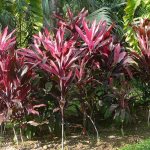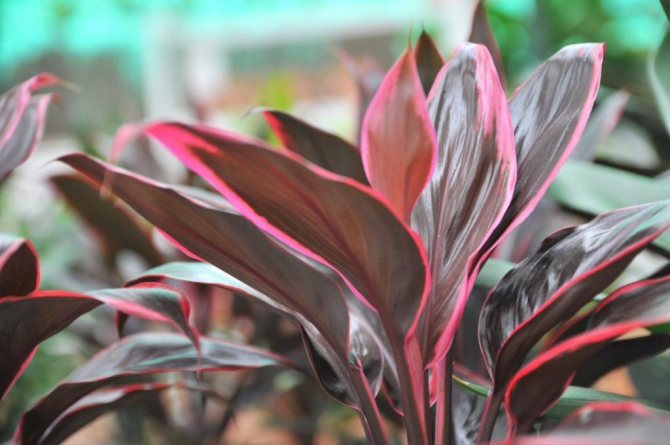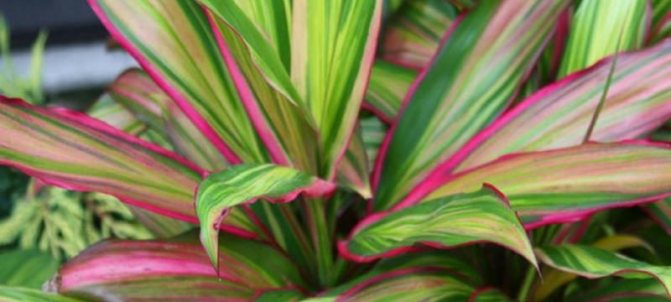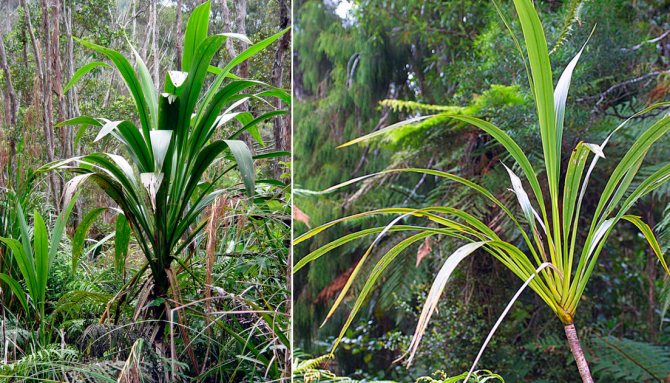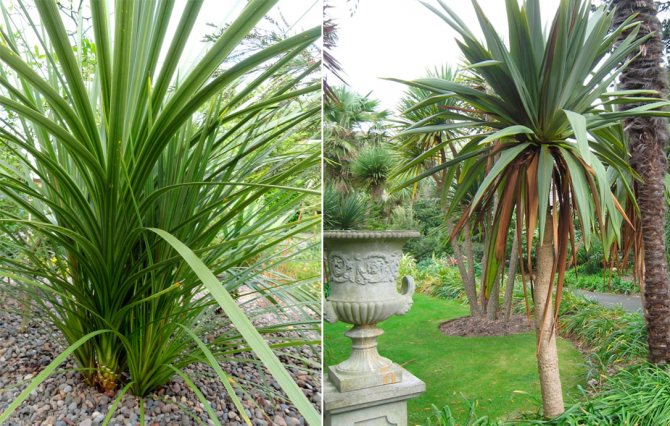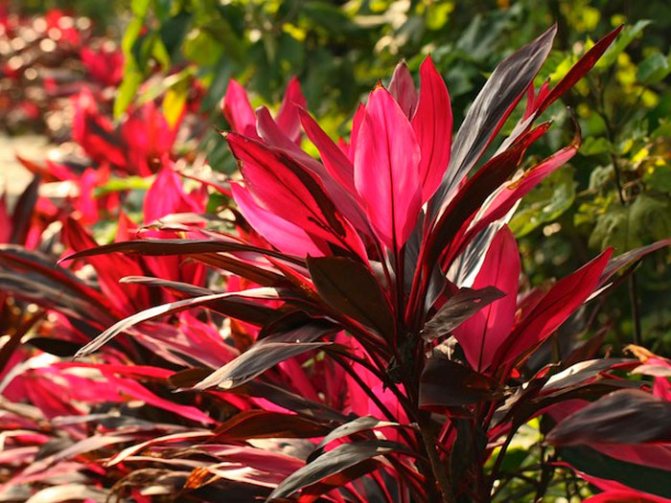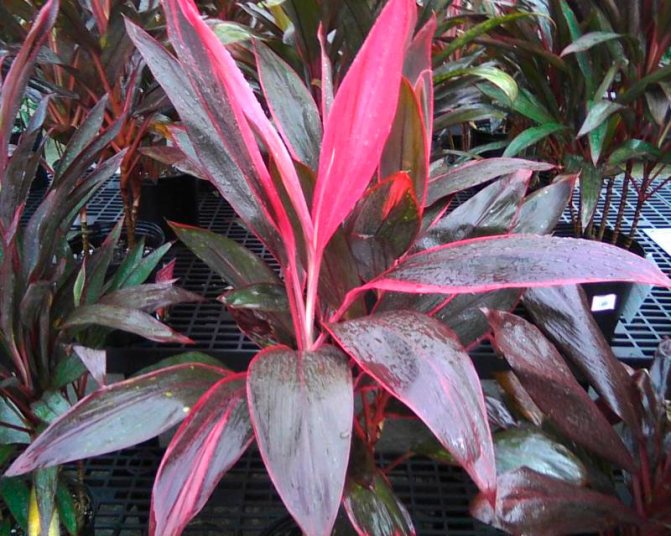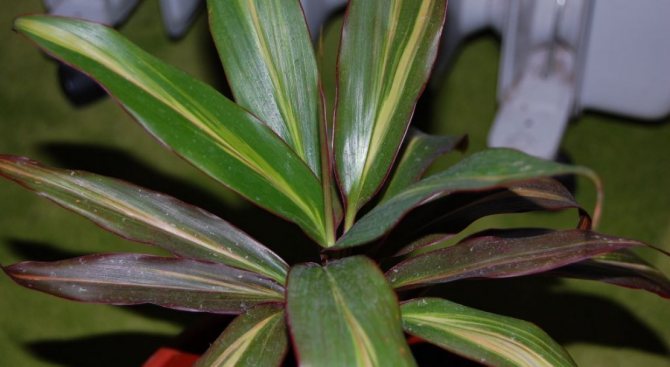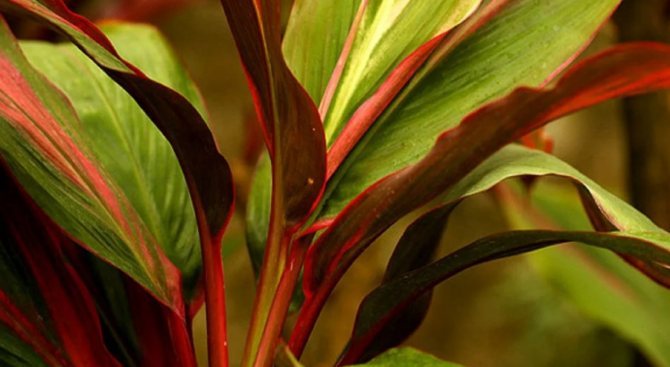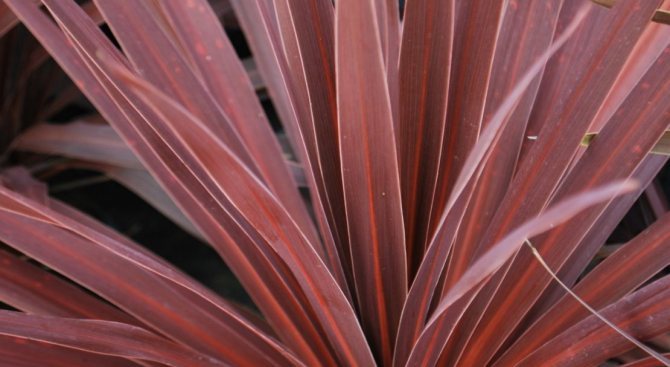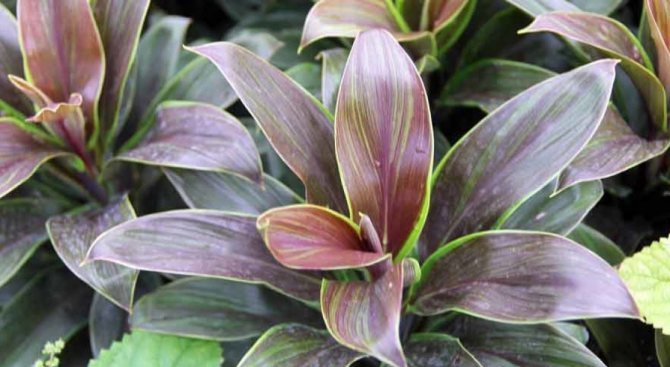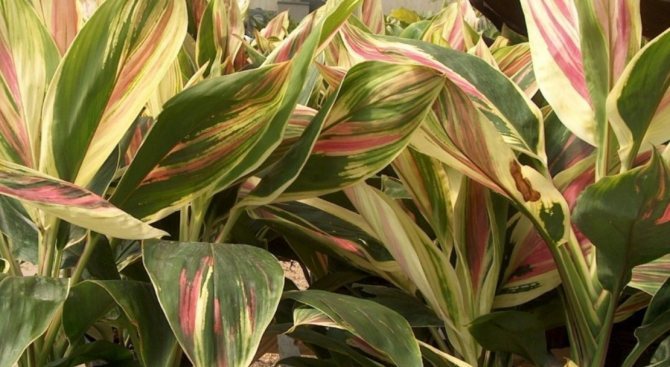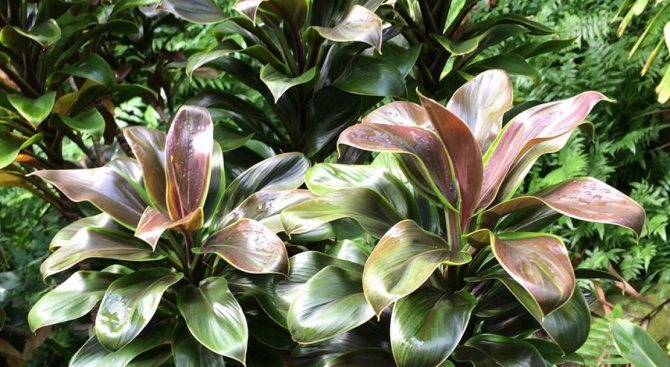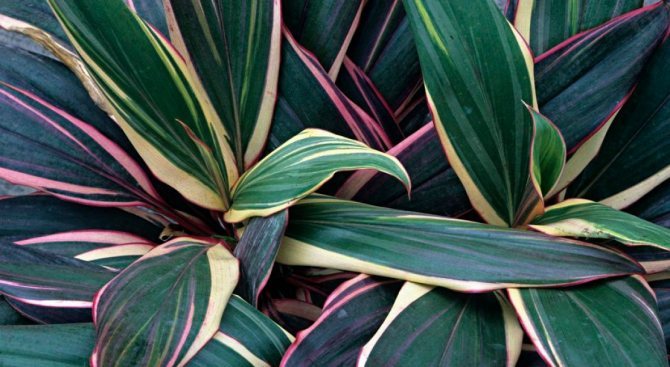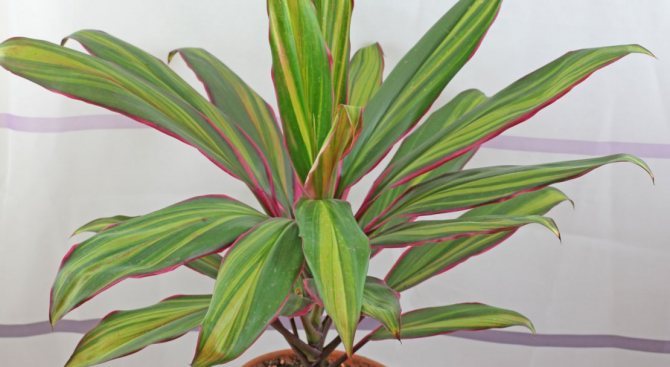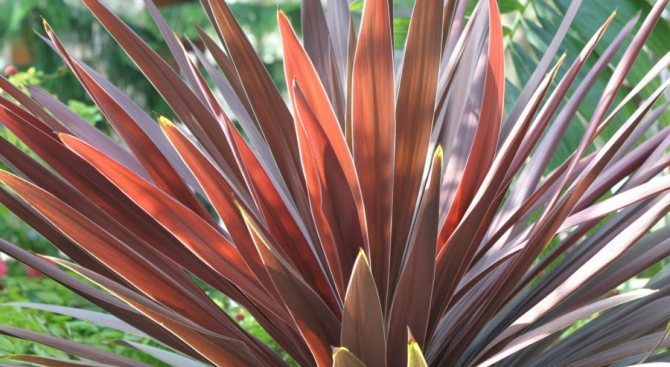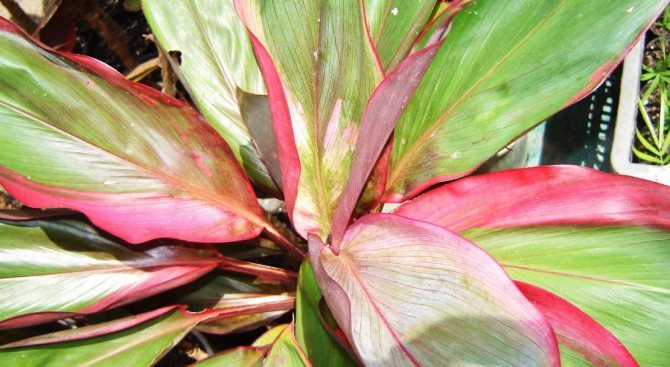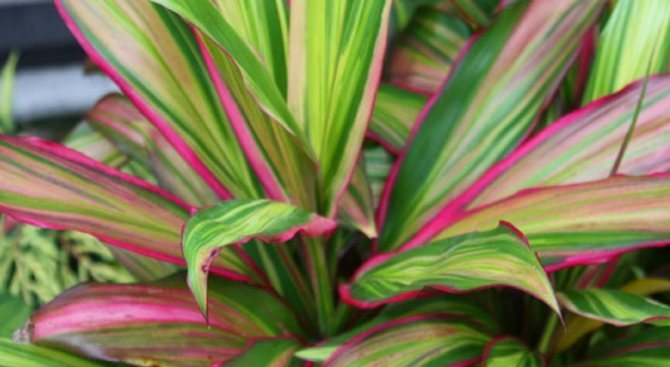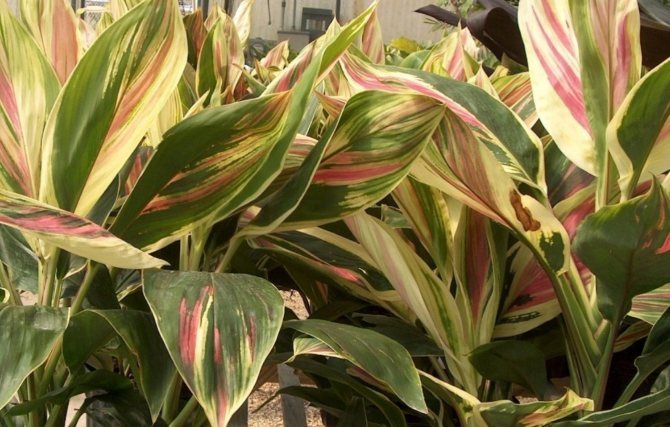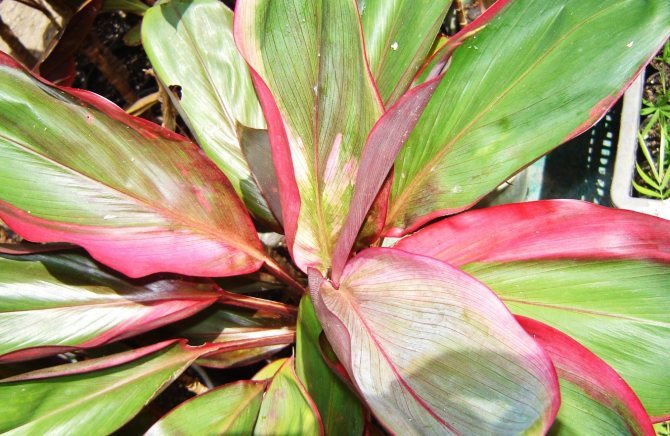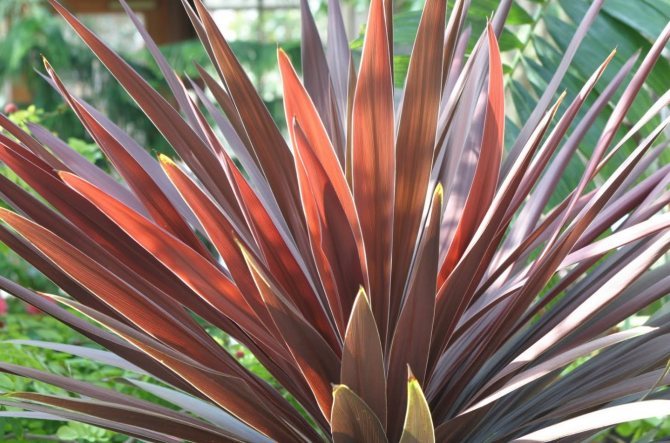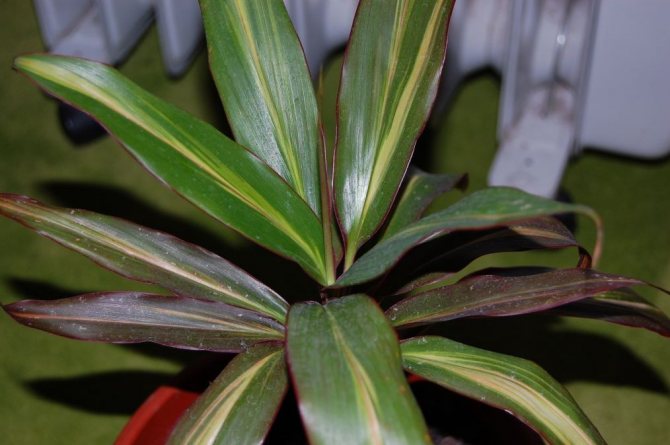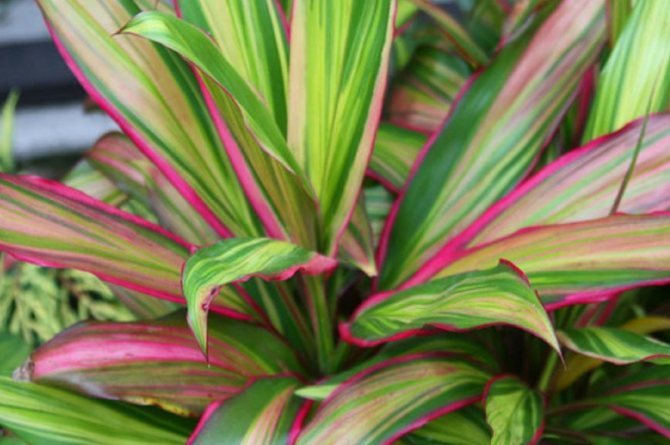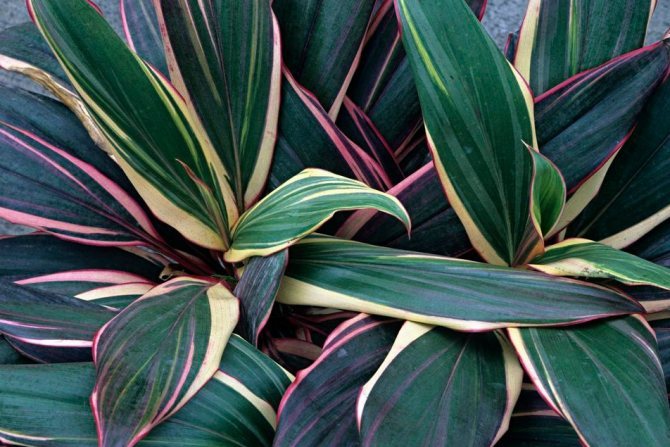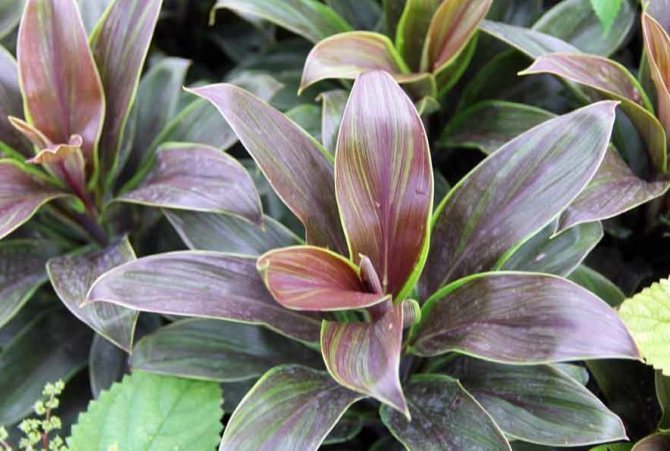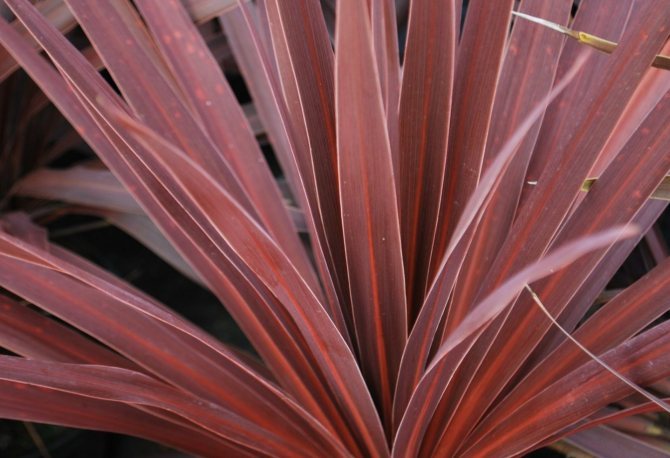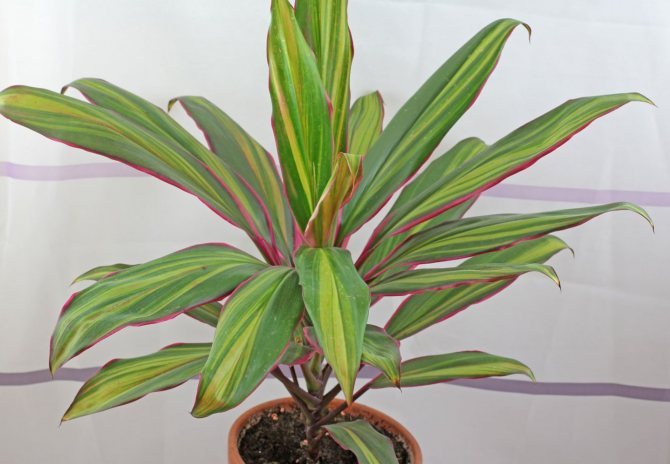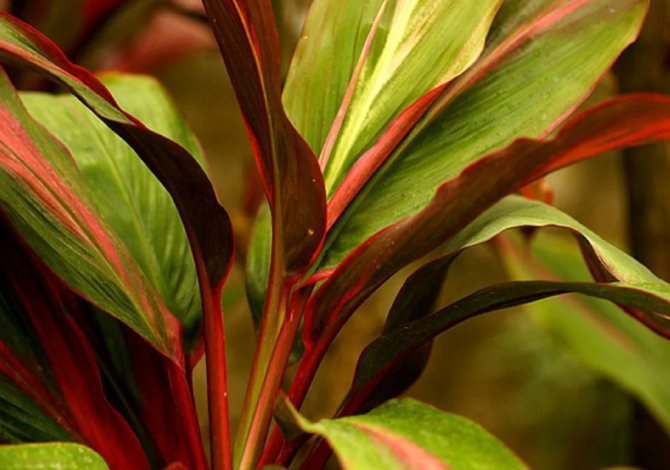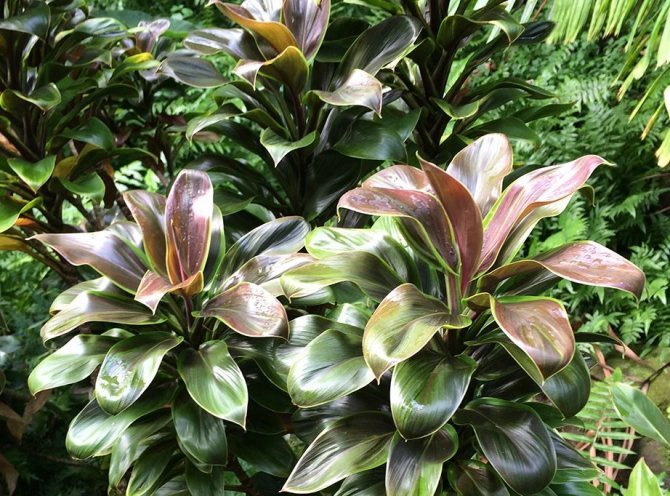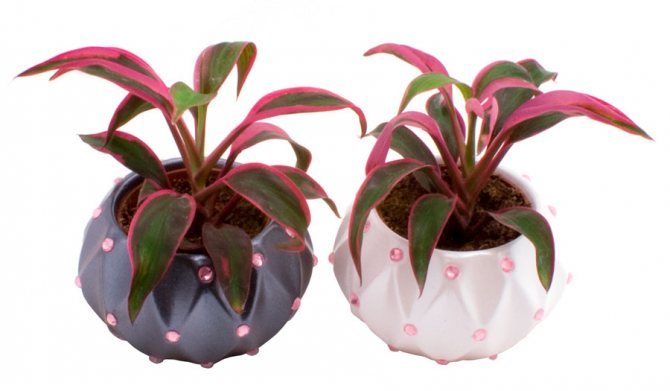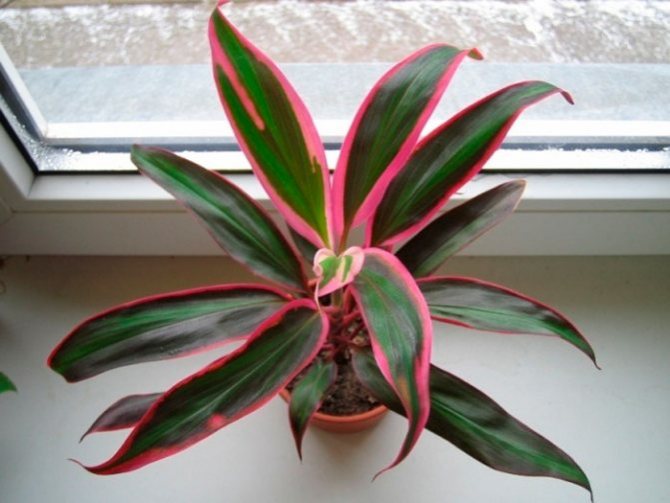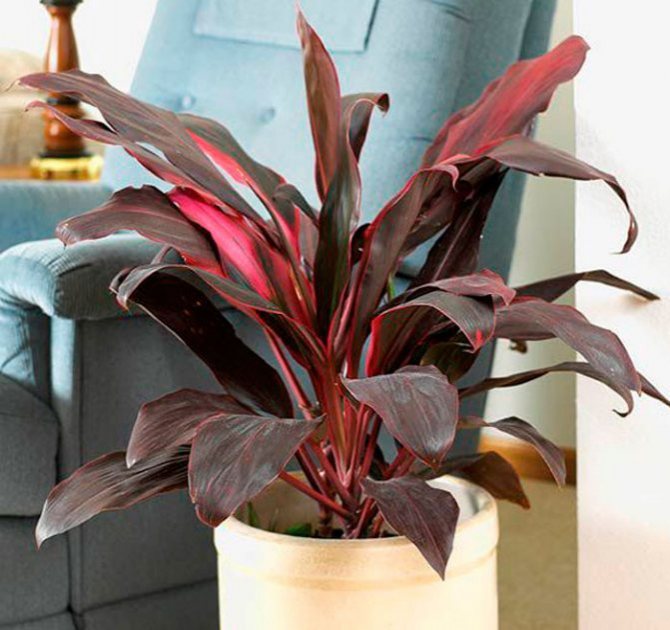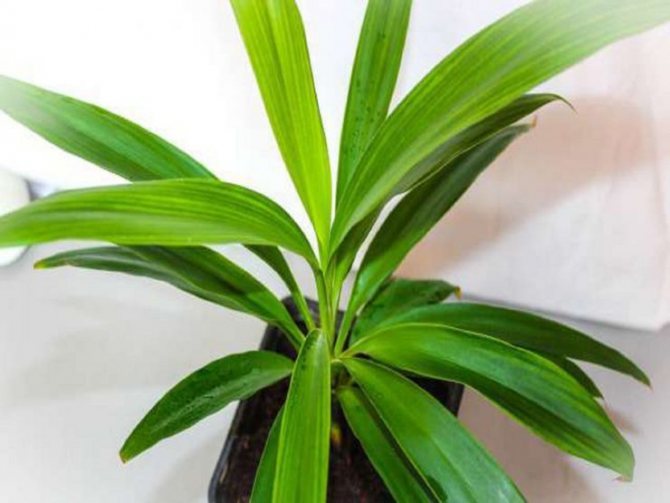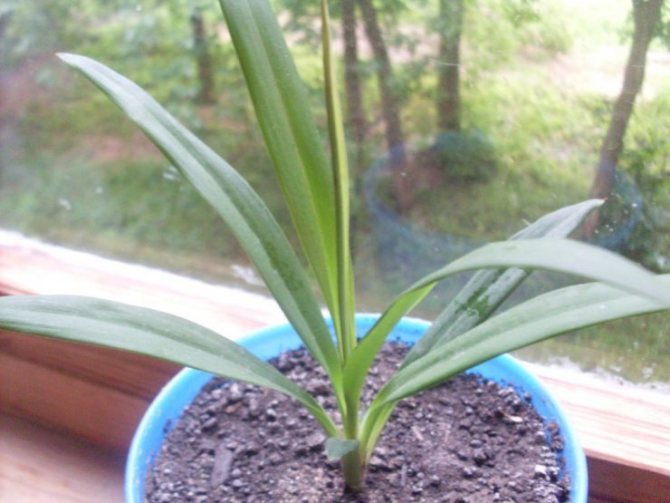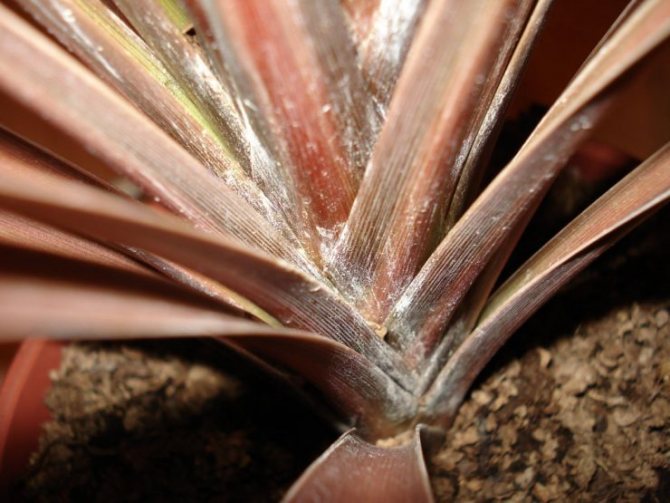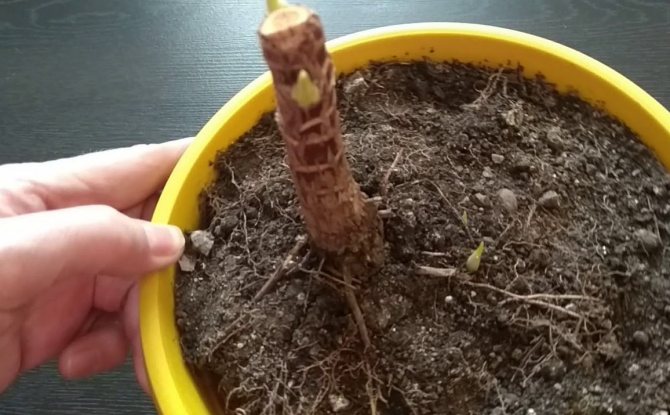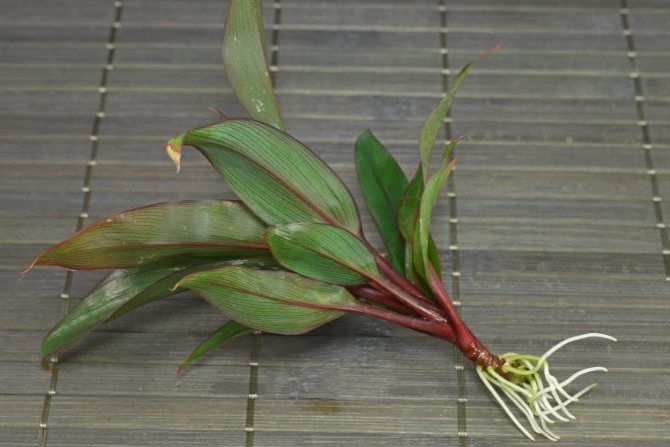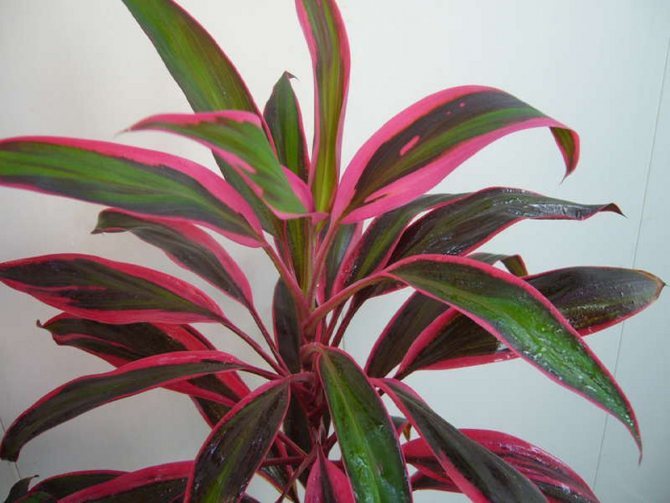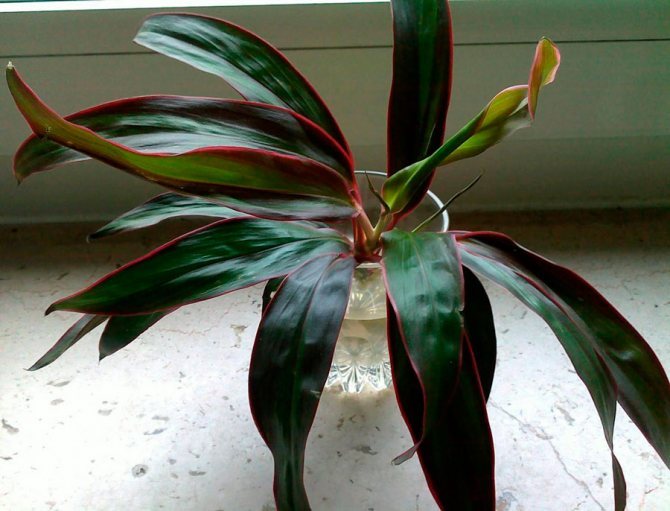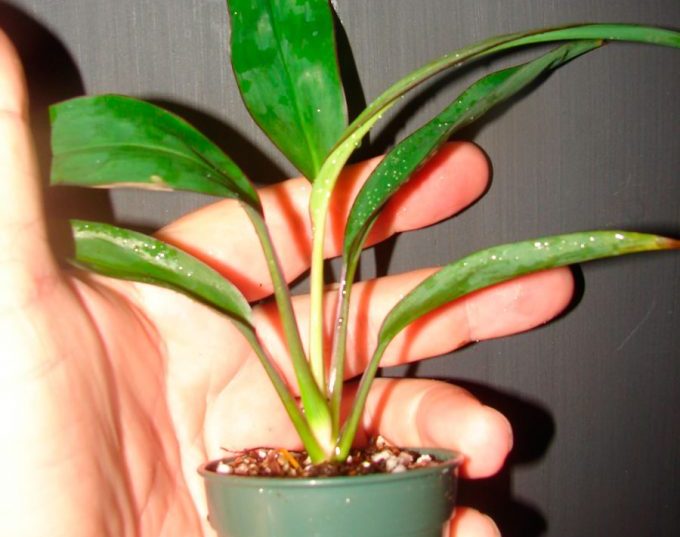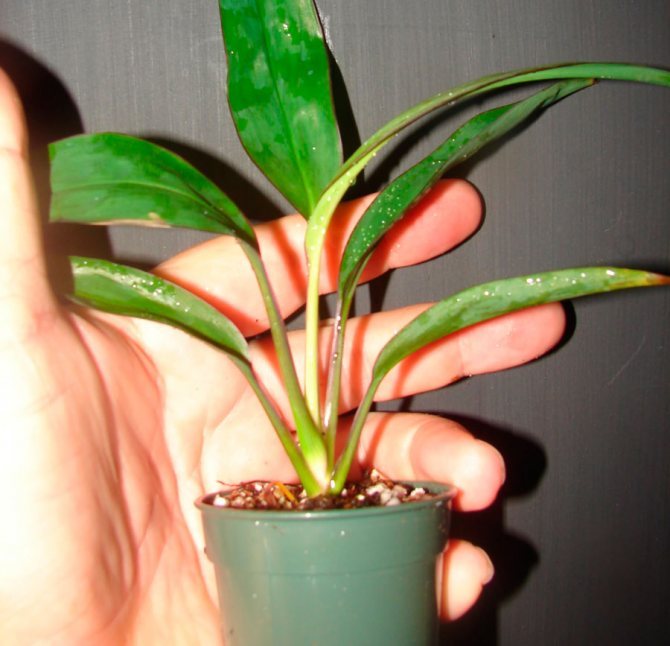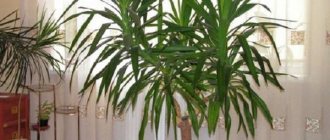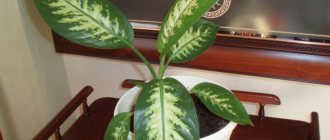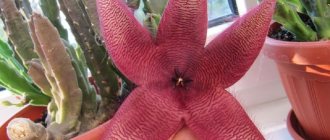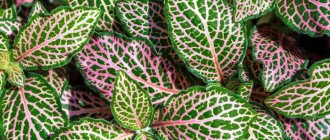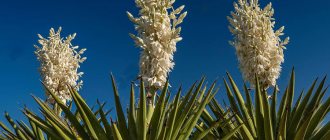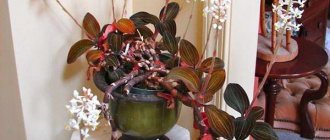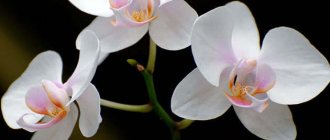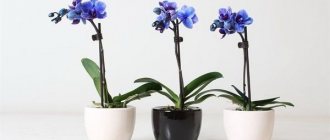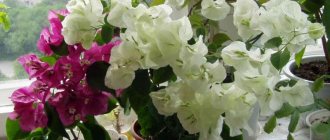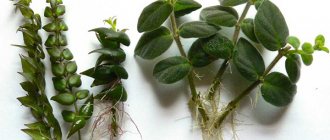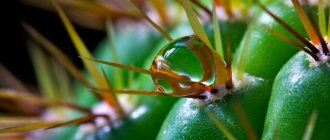The genus Cordyline, belonging to the Agave family (according to some sources - Dracene), has about 15 species of shrubs or trees from the tropical and subtropical regions of Australia, Africa or Asia.
In appearance, the culture resembles dracaena, with which it is often confused. Cordilina leaves of various shapes: lanceolate, xiphoid, elliptical. Their color varies depending on the type and variety of the crop.
With age, the lower old leaves fall off, which makes the plant look like a palm tree with a bare trunk. The root system is powerful with thick roots.
At home, cordilina rarely blooms, but proper care with the creation of conditions close to the natural environment promotes the development of long inflorescences with small but fragrant flowers of lilac, white or pink color.
In nature, the height of a plant can reach 2-3 meters, but in indoor conditions, the height of a tree is usually 60-150 cm.
Cordilina: views and photos
The most popular are 10 types flower.
Apical cordilina
Apical cordilina is a tree with a straight false trunk, which is occasionally weakly branched. Its height can be up to 2 meters.
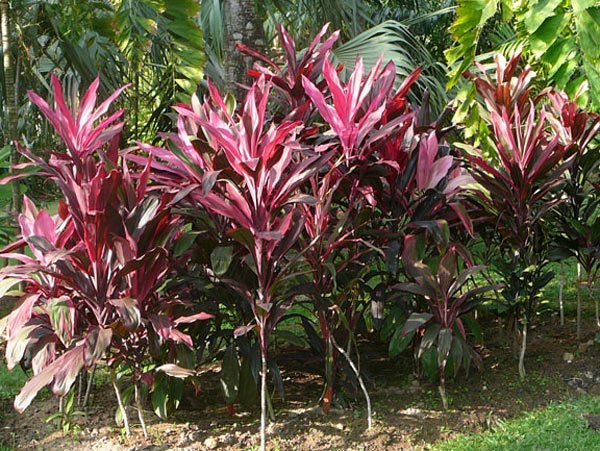
In apartment maintenance, most often the leaves cover the plant from the ground, and the bush remains compact for a long time, without a trunk.
The inflorescence of this species is axillary paniculate. Small flowers are mostly white and less often reddish in color. There are forms with decorative leaves.
Cordilina kiwi
Cordilina kiwi is a fluffy bush-shaped plant. Its leaves are dark green with yellow stripes, bordered. The border of the leaf plates is an intense crimson color.
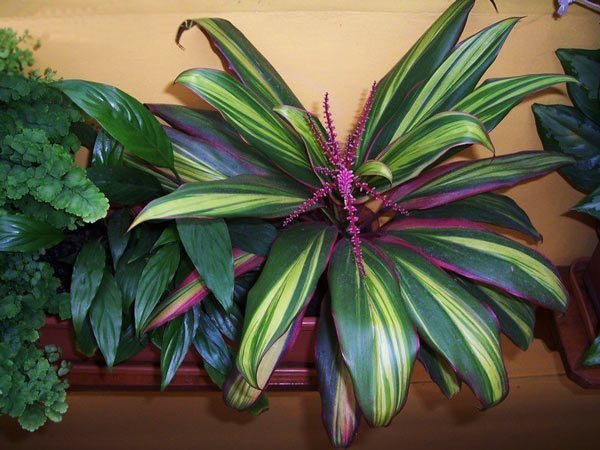

Straight
Straight cordilina is a tall plant with a thin stem that rises to a height of 3 meters. The leaves are large enough, green or purple in color. The species grows better in the cool. The optimal room is with a temperature from +15 to +18 degrees.
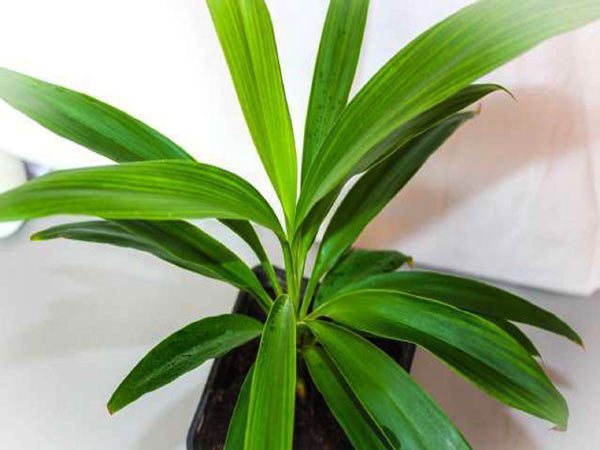

Australian
Australian Cordilina (South Cordilina) is the tallest species, which in nature reaches 12 m. Outwardly, the appearance is most similar to a palm tree. Xiphoid leaves are up to 90 cm long.
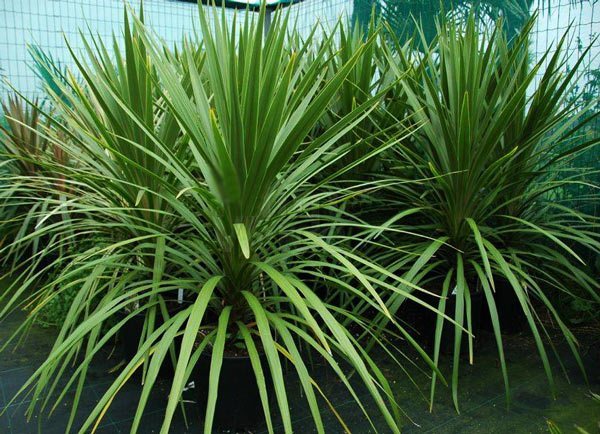

The inflorescences are up to a meter in length and are composed of very fragrant flowers. Sometimes the plant is called South Australian Cordilina.
Red
Cordilina red comes from the Australian continent. Under natural conditions, it grows in bushes up to 3 m high. Because of this, the second name of the plant is Cordilina shrub.
The origin and appearance of cordilina
The genus cordilina unites about 25 species of evergreen trees, shrubs and semi-shrubs. In the wild, they have taken root on all continents in the tropical and subtropical climatic zone. Cordilins grow in the Americas, Africa, Australia, Asia and Europe.
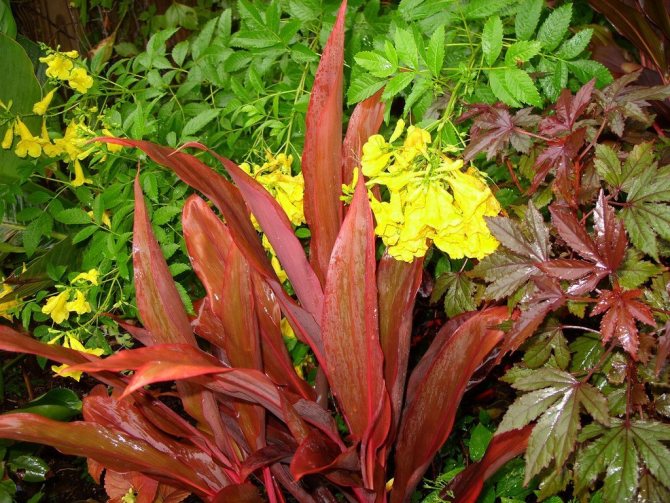

Cordilins are cosmopolitan plants, they have taken root on all continents
These trees, reaching 15 meters in height, or densely crowned shrubs in the southern regions are planted in gardens and parks. In Russia, they can be seen on the Black Sea coast, in the Caucasus or in the Crimea. In colder climates, cordilins are grown in greenhouses, public buildings, and ordinary apartments.
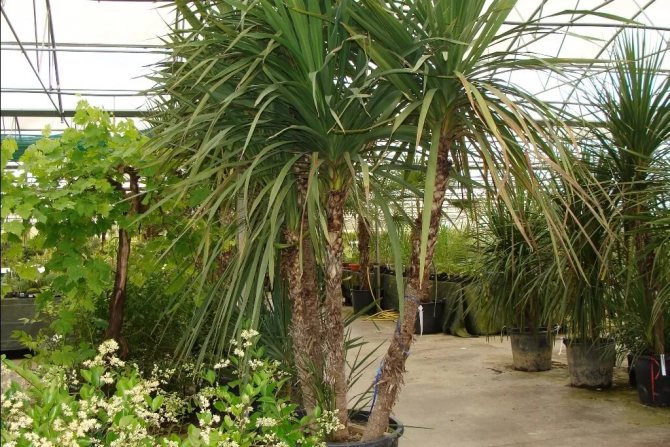

In good conditions and spacious rooms, the cordilina becomes a tall tree
The name of the plant is of Greek origin. The word kordyle is translated as a nodule or knot. So botanists noted the peculiarity of the root system of the cordilina. On its roots there are characteristic knotty thickenings.
The original appearance helped Cordilina win the international love of flower growers. A young plant with a short stem and long (up to 1 meter) oval, belt-like or sword-like leaves over the years becomes more and more like a palm tree. An adult specimen grows up to 2 meters and more.
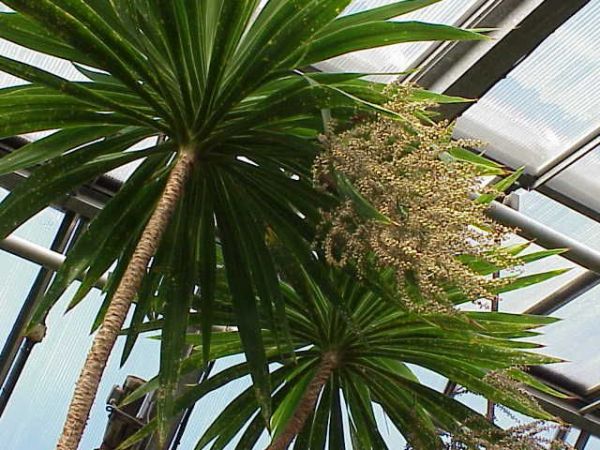

In an adult cordilina, the trunk is bare, and the top holds a bunch of leaves, like a palm tree
A fluffy deciduous cap forms on top of the stiff, bare trunk. She looks especially picturesque in variegated varieties. Leaves can be colored not only green, but also red, yellow, pink, burgundy, chocolate, white or cream. Colored stripes are always located along the veins.
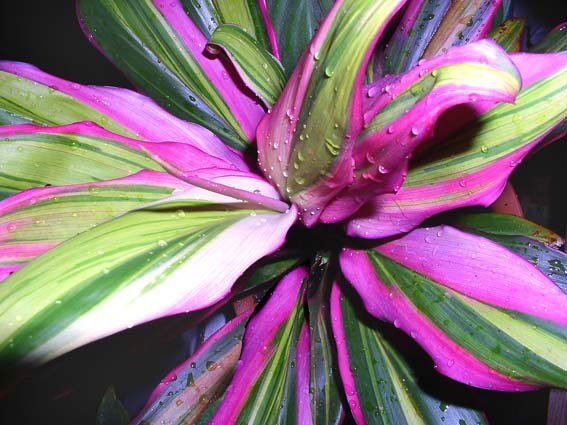

Brightly colored cordilina leaves can successfully replace flowering plants
Compared to such a bright crown, cordilina flowers do not look very advantageous. Small white, lilac or reddish flowers are combined in a panicle. This is an interesting sight, but you can see it only in the southern regions or in the greenhouse. At home, cordilina rarely blooms.


Cordilina flowers are rather curious, but you cannot call them beautiful
The people mistakenly call the cordilina a palm tree. Abroad, it is called the Isle of Man or Cornish palm. And the traveler James Cook, for some reason, gave the Cordilina a strange name - the cabbage tree.
Features of home growing a flower
Cordilina is considered a simple plant for home keeping. This opinion is true for most varieties. For example, the southern cordilina is stoic, it can tolerate partial shade, low temperatures and careless care. But there are also more demanding plants. Variegated forms will lose all their charm if they do not have enough light and need warmth. And all cordilins prefer humidified air, suffer from dryness in apartments with the heating turned on.
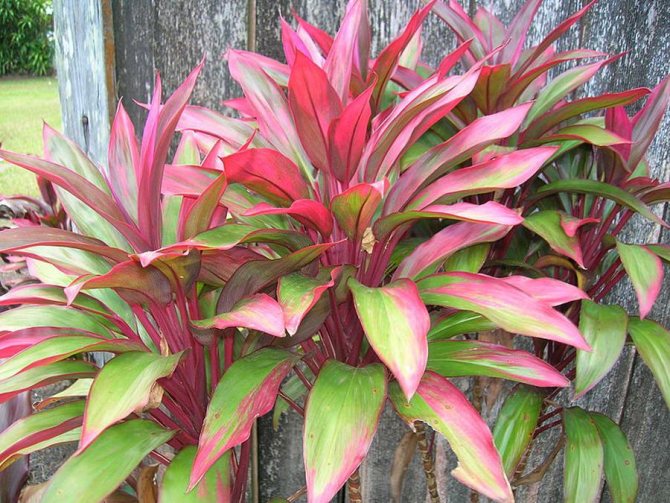

The genus cordilin is diverse, which means that they have different requirements for home maintenance.
Cordilina, unlike many tropical plants, is completely harmless to humans and animals. Its juice is free of toxins. She has no smell. Therefore, cordilina is ideal for growing in a home with children, allergy sufferers and pets.
Young "palms" can grow on the windowsill as long as they fit into the size. Large cordilins are most often grown as a single plant and need room for comfort. With a lack of space, you can choose compact species, these include apical, or bushy. To make it easier to care for the plant, collect a collection of different cordilines and place them side by side. The leaves of these flowers are so different in color and shape that they can be used to make a spectacular composition. And the conditions of detention for Cordilin are generally similar. Therefore, you will save time and energy by spraying and watering more than one flower, but several at once.
Cordilina or Dracaena
False palms are often referred to as yuccas, pandanus and dracaena. Cordilina is often confused with the latter. These plants are closely related, but still belong to different genera. And their appearance is so similar that when buying cordilina, you may well get dracaena and vice versa.


Cordilina roots (left) are white and with small knotty thickenings, in dracaena (right) they are brownish and smooth
You can only find out which plant you have gotten during transplantation. The roots of cordilins are white with characteristic nodules-thickenings. Dracaena have smooth yellow, orange or brownish colors.
Cordilina southern in the wild grows only on the islands of New Zealand. For local aborigines, this is a very significant plant. Fiber for ropes and fabrics is made from its wood. Young leaves are used as food. Cordilina juice is used in folk medicine as an anti-infective agent.
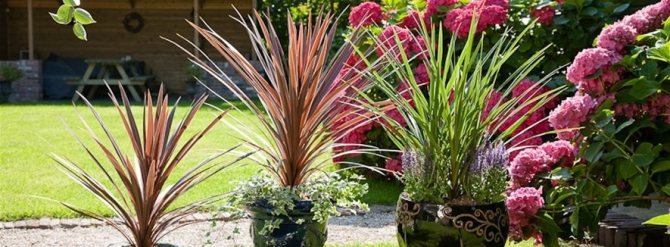

Cordilina southern in its homeland is not just an ornamental, but also a useful plant.
Video: similarities and differences between cordilina and dracaena
Types and varieties
- Southern cordilina (australis) at home in New Zealand is a tree about 12 m tall. The trunk at the base is strongly thickened. The very narrow leaves are long (120 cm) tough but flexible. This species is popular in greenhouses, in the south it is used for landscape design and is especially common in home floriculture. The room grows about 2 meters. This is a hardy plant that can withstand temperatures up to + 3-5, can grow in partial shade and will forgive you some care mistakes. Variety Purpurea has reddish purple foliage.
- Unseparated cordilina (indivisa) is a species with narrow (1-1.5 cm) and long leaves, they are green, the middle vein is light red. In open ground it grows up to 12 m, in a room more than 2 meters. In subtropical climates, this species is cultivated as a garden species. Withstands a drop in temperature up to +3 degrees. When kept at home, it needs a cool winter.
- Cordilina Banks is very similar to the dragon dracaena. On a woody stem (maximum height - 3 m), a dense bunch, directed vertically, of long rigid leaves. They are bluish-green, xiphoid in shape. Inflorescences are white panicles. Cordilina Banks is often grown in greenhouses, on insulated balconies, less often at home. Winter temperature should not drop below +8.
- Cordilina Haaga is a small (up to 80 cm) shrub with thin shoots. On long (10 cm) petioles, the leaves are in the form of an extended oval, drooping. The green leaf blade is leathery, with prominent veins. The flowers are purple, gathered in loose panicles. This cordelina is suitable for a winter garden, sheltered balcony, but can also grow at home.
- Cordilina red (rubra) is a shrub plant. The maximum height is 4 meters. Rough, large, broadly oval leaves are located on a rather thin shoot. The colors are very bright: a combination of dark green, burgundy and red stripes. Cordilina red is grown as a greenhouse and indoor ornamental plant. It can also grow in open ground, if the temperature in winter is not lower than +6.
- Cordilina straight (stricta), or compressed, is a tall look even with room content. The thin barrel can be up to 3 meters. Green leaves are located throughout the shoot, they are elongated and narrow, with a jagged edge. Inflorescences are white or purple. The plant prefers a cold (+ 5–7) wintering; for the summer, the pot can be put outside.
- Small cordilina (pumilio) is an interesting plant. On a small trunk (no more than 1m), a bunch of bluish-green narrow leaves. They form a spherical crown. This cordilina is mainly grown in greenhouses, a rare species in home floriculture.
- Cordilina shrub (fruticosa), it is also apical (terminalis), grows in its natural environment in India, Malaysia, Australia and Hawaii. This is not a tree, but a shrub. The maximum height is 70 cm. On a short stem, oval-elongated leaves are densely located, up to 50 cm long. Due to its compact size, this shrub cordilina is widely cultivated in greenhouses and at home. But this species requires more careful care, the plant is warm and moisture-loving, needs good lighting.
Many forms of bush cordilina have been bred, differing in the width of the leaves and their color. The most popular varieties:
- Kiwi - a form with wide leaves, they are decorated with white-cream stripes, the edge is crimson;
- Joungii is a cultivar with long leaves of medium width, ranging in color from red to brown.
- Canario is a cordilina with medium wide leaves, color with lines of different shades of green.
- Tricolor - variety with variegated oval leaves, burgundy, yellow and red streaks along the vein;
- Red Edge - this cordilina has a dark green foliage, and the edges and ends are painted in a deep red-pink color;
- Baptisii is a very original variety, leaves with green, pinkish and orange stripes;
- Nigrorubra - a form with unusually dark foliage, it combines green and burgundy colors;
- Rumba is a variety with narrowish, upward-looking leaves, the main color is dark green, and the border is pink;
- Chocolate Queen - cordiline with very wide, curled down leaves, stripes on them are green, yellowish and the color of milk chocolate;
- Cordilina compacta is a small bush up to 30 cm, with oval dark, green-red-brownish leaves, bent down.
What do different types and varieties look like
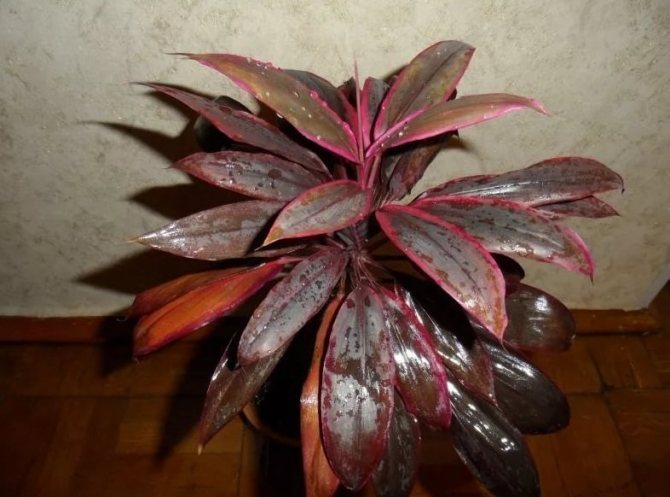

Cordilina Baptisii has a bronze-tinted foliage
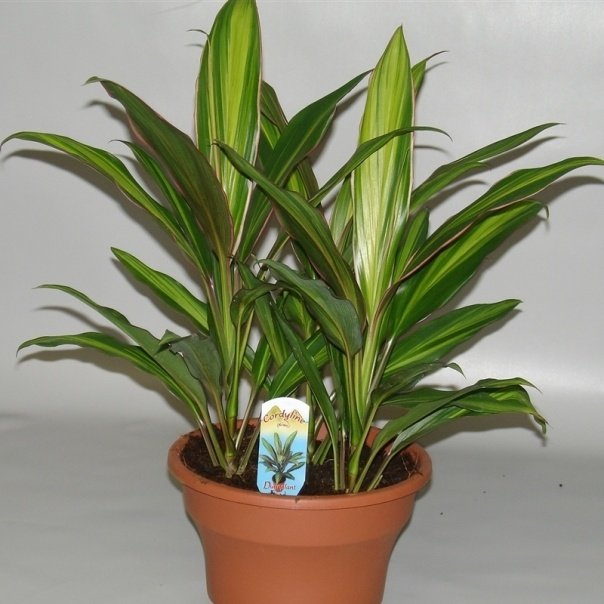

Cordilina Canario is a graceful variety with green foliage
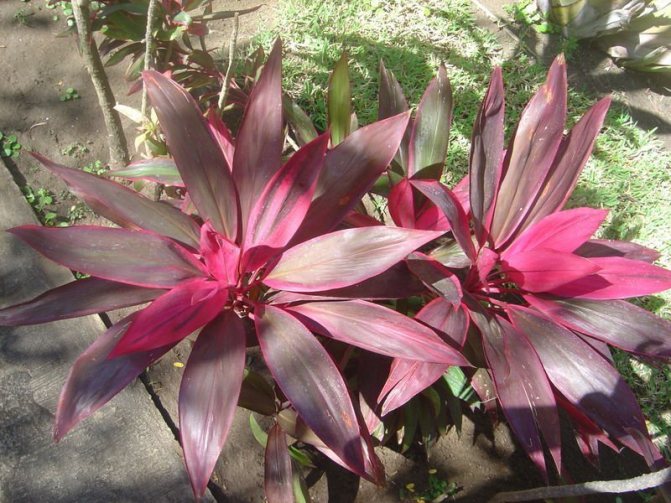

Cordilina Joungii - young leaves are red, old brownish green
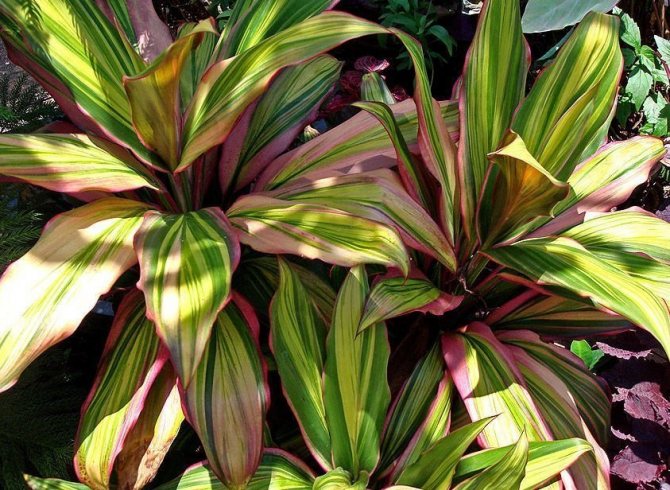

Cordilina Kiwi is one of the brightest varieties


Cordilina Nigrorubra - burgundy green leaves
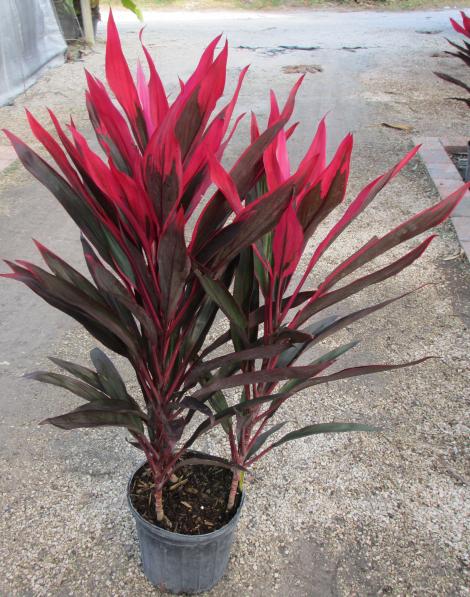

Cordilina Red Edge - the plant seems to be on fire
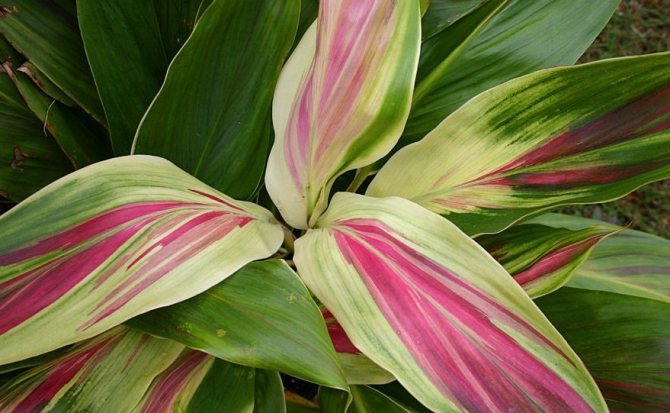

Cordilina Tricolor - wide leaves with a harmonious pattern
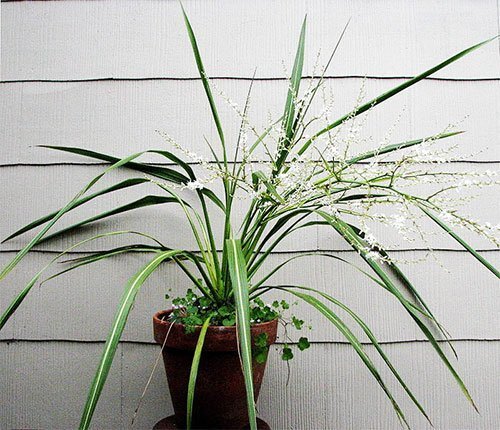

Cordilina Banks - narrow leaves, and hardy character
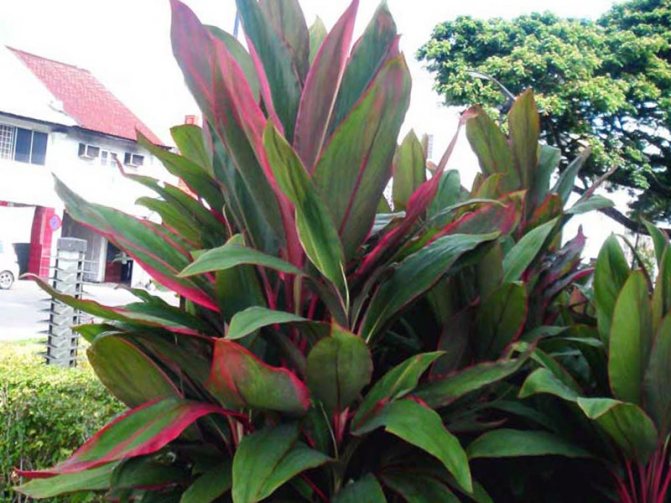

Shrub cordilina - this species became the basis of most indoor varieties
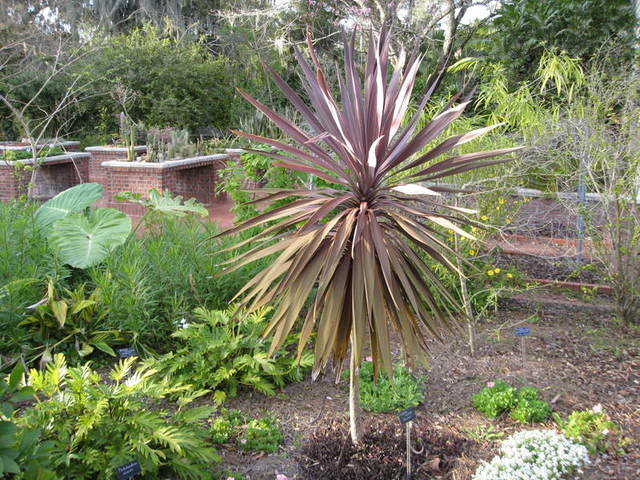

Small cordilina is an interesting, but rare plant in our area
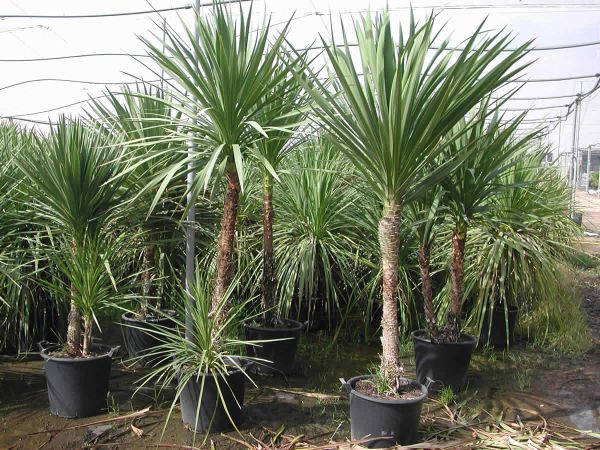

Cordilina undivided - hardy and tall species
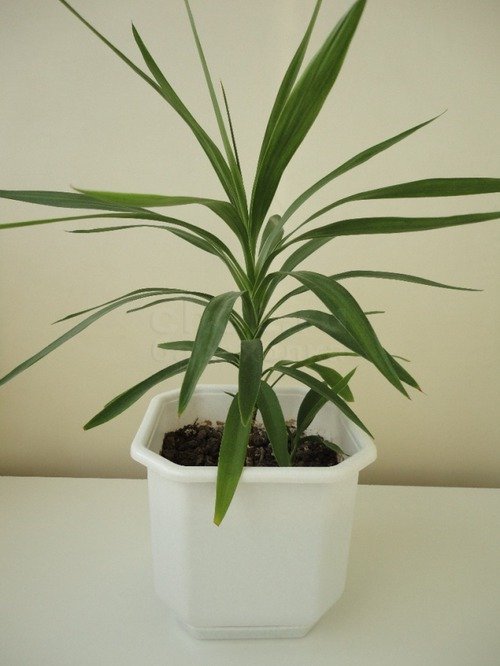

Cordilina straight - an adult plant can grow into a tree even at home
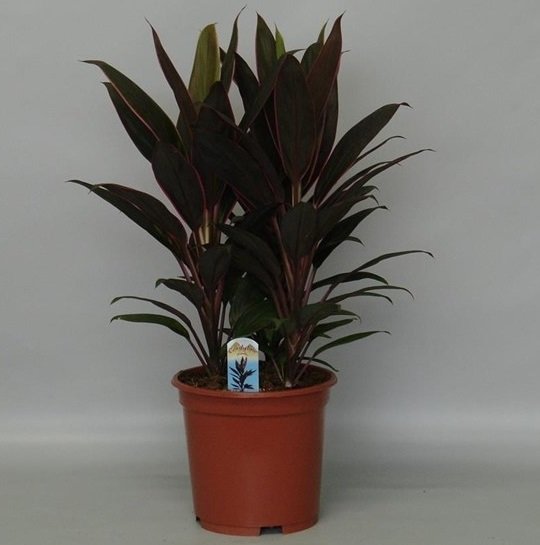

Cordilina Rumba - shrub variety
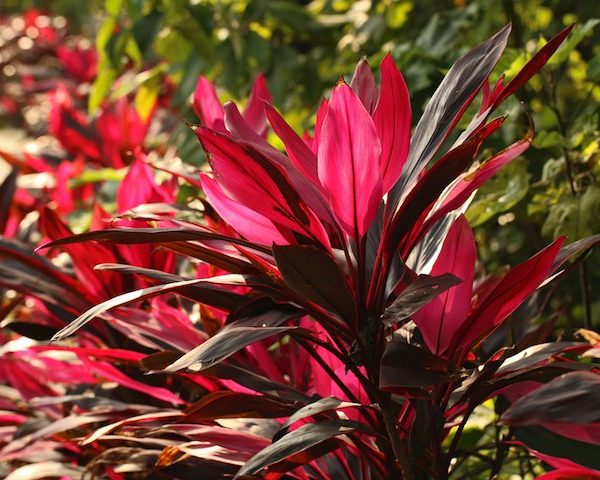

Cordilina red - scarlet leaves are not the merit of breeders, but a creation of nature
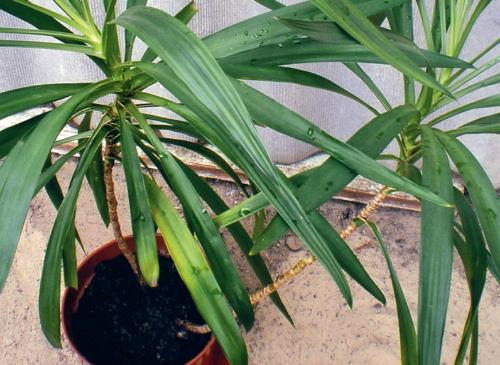

Cordilina Haaga - small shrub
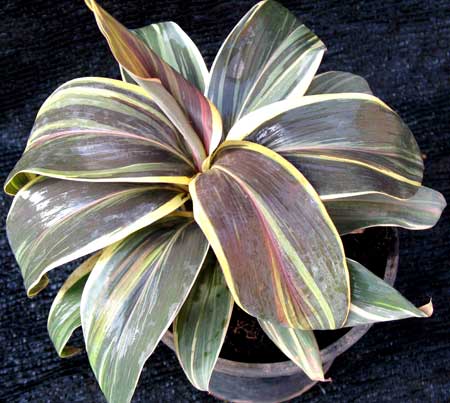

Cordilina Chocolate Queen - variety with leaves painted in chocolate tones
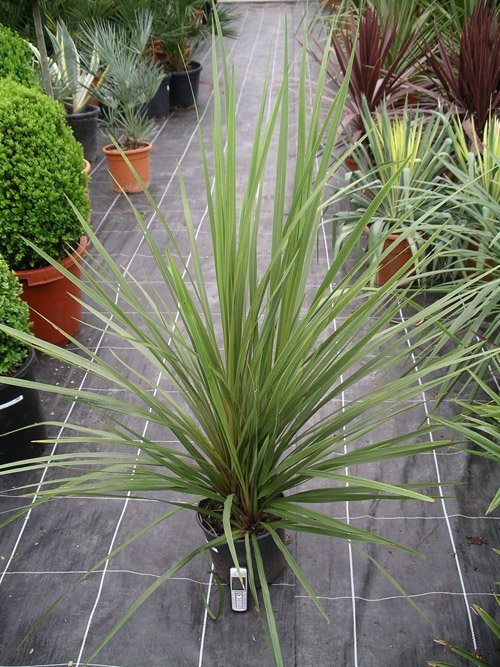

Southern cordilina - plant patient with conditions and care
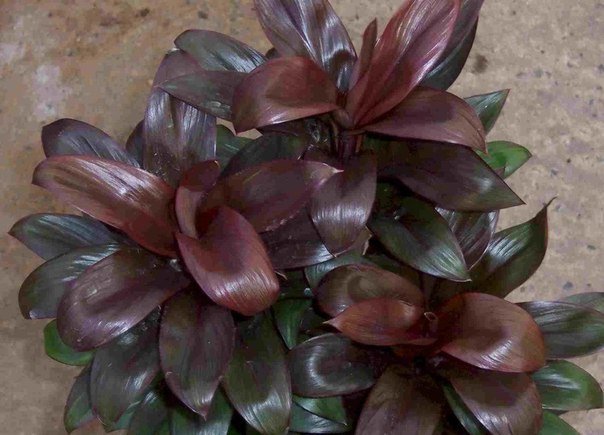

Cordilina compacta - a miniature form with bent leaves
Video: cordilina in the open field
Botanical description of the plant
Some experts consider Cordilina to be in the agave family, others to asparagus. Its name comes from the Greek word that translates as "knot, bump", since the plant has knotty, pineal roots. New Zealand and Australia are considered the birthplace of the cordiline plant. It is often confused with dracaena because of its external resemblance. However, these plants belong to different genera. The flower has a high trunk, the bottom of which becomes bare over time, and beautiful decorative leaves.
Did you know? Unlike most tropical plants, cordilina does not contain any toxic substances. Therefore, it can be grown in homes with small children and pets.
The plant resembles a palm tree in appearance and has the following characteristic features:
| Root system | Fleshy, tuberous, thick, white |
| Stem length | Up to 1.5 m in apartment conditions, up to 12 m in the wild |
| Leaf shape | Lanceolate, sword-shaped or linear |
| Leaf color | Green, found with red, light green, pink veins, stripes, spots |
| Inflorescence shape | In the form of a panicle, with small flowers |
| Flower color | Red, white, purple |
Types of cordilin
There are 26 types of cordilin, among which are trees, shrubs and semi-shrubs.
In apartment conditions, the following are more often grown:
- Banks. Reaches a height of 1.5–3 m. The trunk is thin and straight. The leaves are green, lanceolate, up to 1.5 m long and 8 cm wide, placed on long petioles. In a panicle-shaped inflorescence, white flowers are formed.
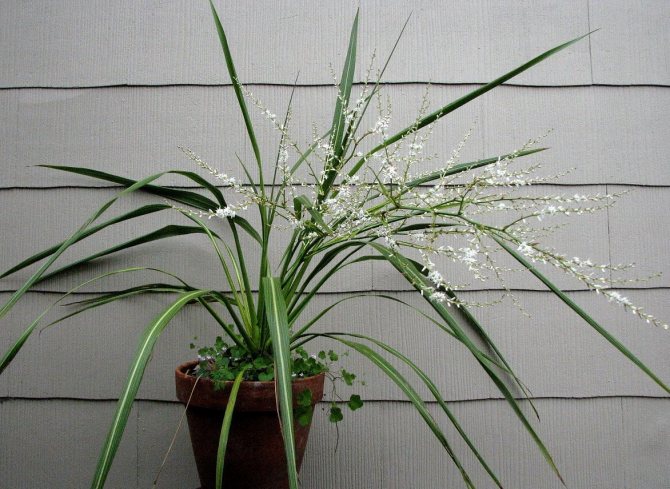

- Apical. It can have 1 thin or several trunks. The leaves are green with a reddish tint, with pronounced veins. It grows in length up to 50 cm, in width - up to 10 cm.
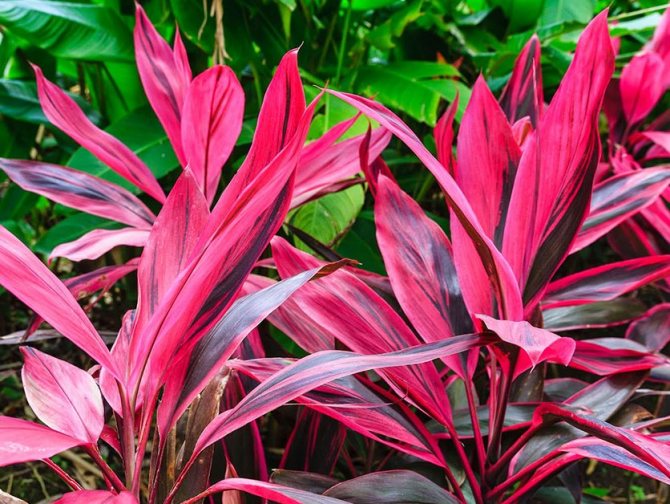

- Red. Grows up to 4 m in height. The leaves are green, lanceolate, long and narrow.Their maximum length is 0.5 m, width is 5 cm. They grow on petioles 15 cm long. During flowering, an inflorescence is formed in the form of a panicle with pale blue flowers on short pedicels.
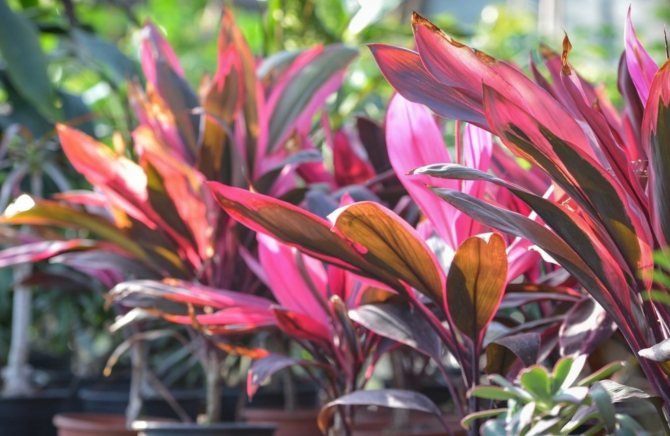

- Straight. Forms a thin trunk up to 3 m long. Leaves are lanceolate, up to 0.5 m long and up to 3 cm wide. Inflorescences are in the form of panicles. They contain pale blue flowers.
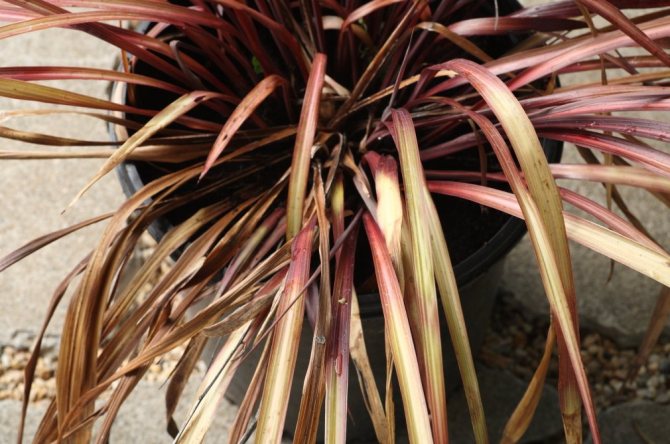

- Undivided. Tall species - in the wild it can reach 12 m. The trunk is thin and hard. The leaves are long, belt-like. Their length is 1.5 m, width is 15 cm. A red vein runs in the center of the matte green upper leaf plate. The inflorescence is branched, drooping. The flowers are white.
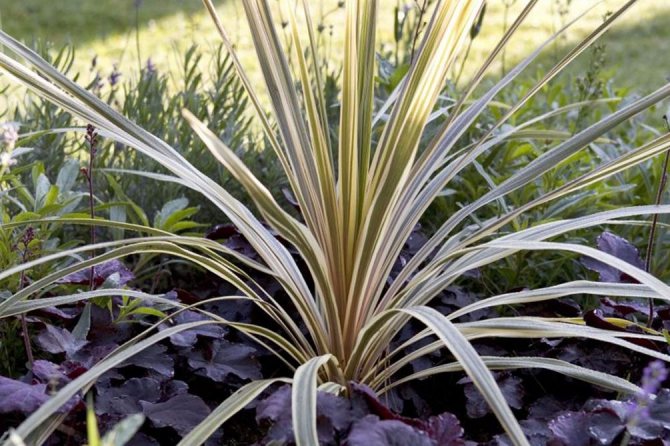

- South. Another tall species. The trunk is straight, widened at the base. The leaves are long, in the form of swords. Green in color with a light central vein. The inflorescences contain delicate white fragrant flowers.
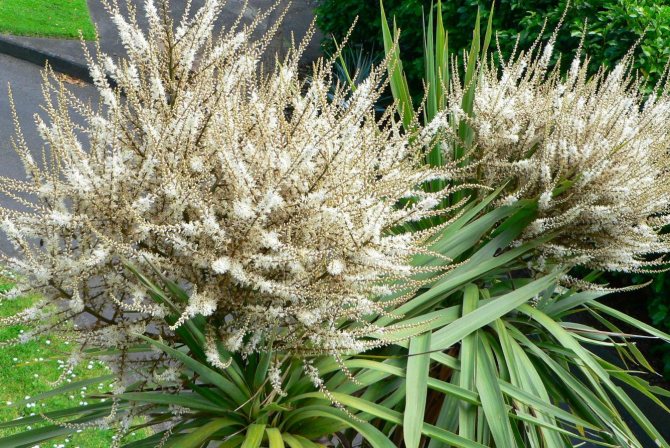

Growing at home
For the plant to feel normal, it needs high-quality care.
| Temperature | In summer and winter, the temperature for the flower should change. In the warm season, the optimal indicator is from +20 to +25 degrees. In winter, you need to lower the temperature to +14, + 16 degrees. |
| Lighting | The need for intense light, but without direct rays of the flower. The plant feels equally well in natural and artificial light. |
| Watering and humidity | The need for water is high. In summer, the flower is watered after 3 days, and in winter - after 5 days. Air humidity must be high. The leaves are sprayed on 2 sides every day. |
| Top dressing | Top dressing is carried out with a complex universal fertilizer for indoor flowers from March to the end of September, once every 2 weeks. |
| Transfer | The transplant is carried out only at the moment when the roots of the flower go outside the pot. In the spring, the topsoil is replaced annually. For drainage, a layer of expanded clay 3 cm thick is placed on the bottom. Without it, the roots will rot. |
| The soil | The soil is necessary nutritious consisting of sod land, deciduous land and rotted manure taken in equal quantities. If the soil for cordilina is too dense, it can be thinned with sand. |
How to care for a flower
Since this plant lives in different parts of the world, each variety or species requires individual treatment and care, depending on its characteristics and place of cultivation.
Environment
- The most frequent places of growth of cordilina in nature are the forests of the southern part, where there is a lot of diffused light. Such a sunny environment is what Cordilina needs. The best option is to plant a flower on the south side in winter. During warmer seasons, the east or west side will do.
- It is necessary to maintain a temperature regime of about 22 ° C in summer. Closer to winter, you need to gradually reduce the temperature by transferring or replanting the flower to a cooler place and by winter the temperature should be about 8 ° C.
- Try not to allow cold winds and sudden changes in the temperature of the environment around the plant to weather the plant. This can adversely affect its growth.
- In winter, warmth-loving varieties should be grown at 16-20 ° C.
- Air humidity plays a significant role. You need to know what kind of cordilina you have: tropical or subtropical. The first one is used to high humidity and it is better to spray it from time to time in the summer. The second grows well in normal indoor conditions without spraying.
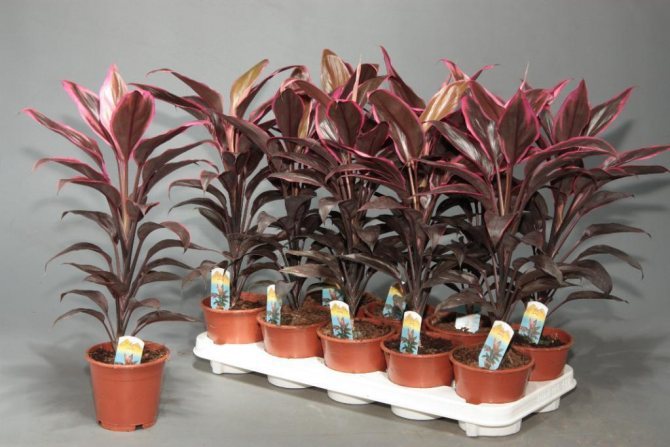

Watering and feeding
This procedure should be performed periodically. It is better to choose soft, slightly cool water. Try not to overdry the plant, but abundant watering is not needed, especially in winter, when it is worth doing it very sparingly.
As for dressings, they are carried out in the summer and spring 4 times a month, and in winter, one dressing per month is enough. A combined fertilizer for ornamental deciduous plants is well suited for this. If the room is cool, then cordilina slows down its growth and does not need feeding.
general description
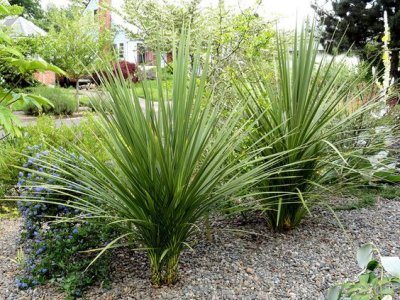

The homeland of Cordilina, called Cordyline in Latin (from the Greek word "knot, bump" - in the shape of the rhizome), is the tropics of the whole world.
In the bosom of nature in Australia, Africa, America and Asia, it grows in the form of a tree or shrub of impressive size.
In room conditions, Cordilina does not grow too high - no more than 2 m.
The Cordilina false palm is a perennial evergreen of the Agave family. Depending on the species, it can grow in the form of a tree or a bush.
The stalk of the Cordilina is prone to lignification and exposure due to the dying off of the lower leaves as it grows, for which in everyday life it is nicknamed "false palm" - by the similarity with real palms.
The roots of the plant are very fleshy, creeping, knotty, white. Leaves with or without a central vein are arranged on petioles. When flowering, Cordilina shrub is decorated with panicles with small flowers.
In addition, Cordilina has leaf petioles and a central vein, which dracaena does not have.
The genus Cordilin includes various types of plants - about 20 in total. They have green or variegated leaves - with pink, red or creamy strokes or spots. The following varieties are most popular among plant breeders:
- Cordilina straight - a plant with wide leaves, characterized by a matte surface, the height of which ranges from 1.4 to 2 m.
The photo shows the indoor flower of Cordilin:
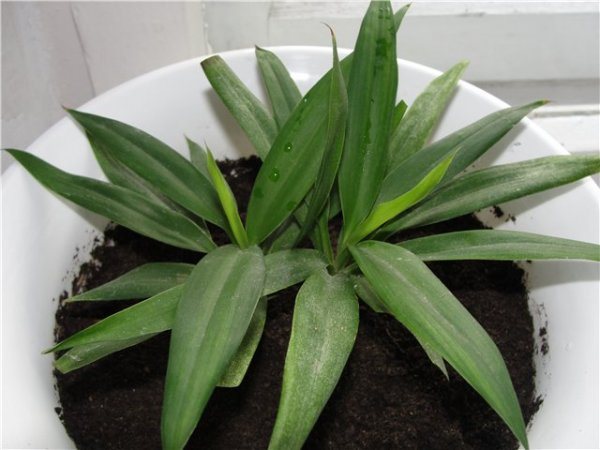

Cordilina kiwi is a shrub with luxurious green foliage, often framed by a burgundy border.
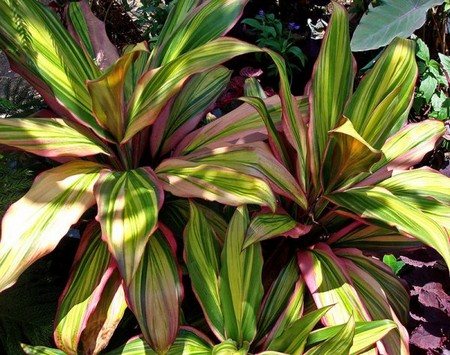

Cordilina fruticose is a species that grows extremely slowly and does not lose its lower leaves for a long time, numerous varieties of which are distinguished by the most varied colors.


Southern cordilina is a tree with a thick trunk at the base and long, up to 1 m, narrow and hard leaves, a bunch of which is located at the top of the plant.
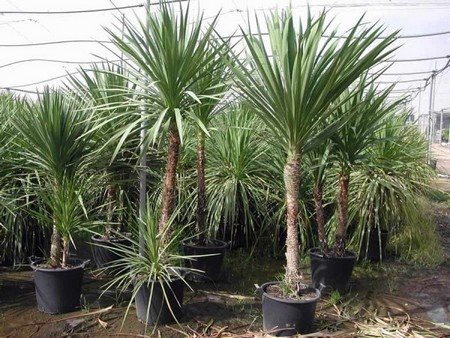

Cordilina mix is a general name used for batches of seedlings of various types and varieties.
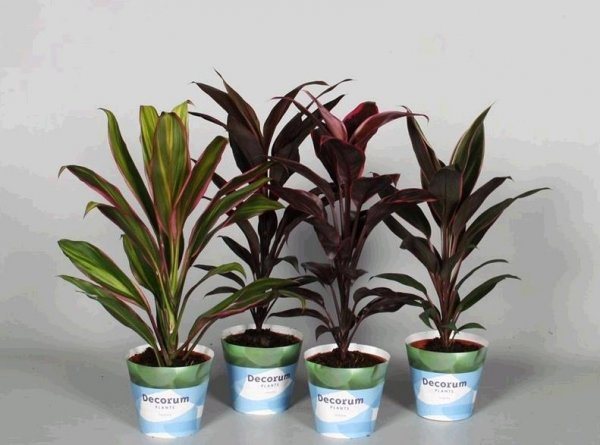

Apical cordilina is a plant with large, up to 80 cm long, green leaves, variegated with red or pink marks and located at the top of the shoot, with a woody stem, which branches or not, with pink or white flowers and a great love of sunlight.
Read also: What kind of firewood is better for the stove: types, comparative review
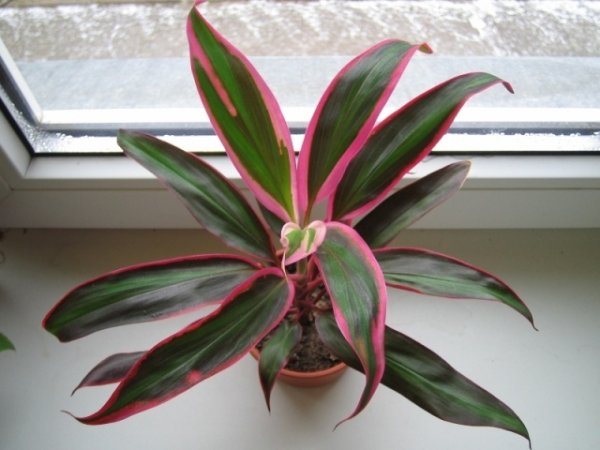

Undivided cordelin is a tree with narrow leaves up to 1 m long at the base, often decorated with a crimson border and an orange central vein, as well as gray-gray on the underside.
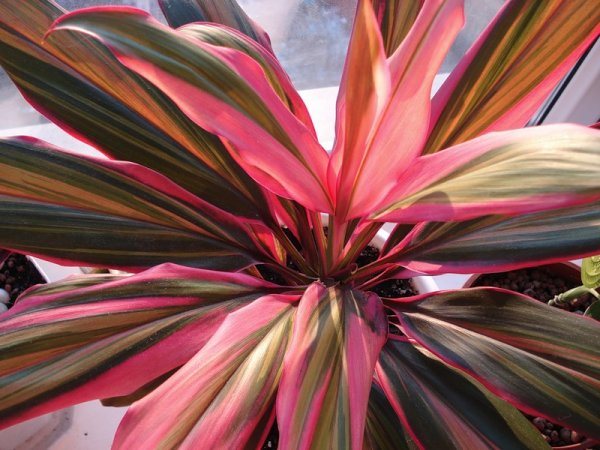

Reproduction
The plant propagates by seeds or vegetatively. In an apartment, seed reproduction is not effective., since new plants do not retain the characteristics of the maternal.
When grown from seed, they are sown in spring in moist soil made up of equal parts of sand and peat. Seeds are covered to a depth of 1 cm. After that, the pot is covered with foil. Sprouts appear in 2 weeks. Diving of seedlings into separate pots is carried out in the phase of 4 true leaves.
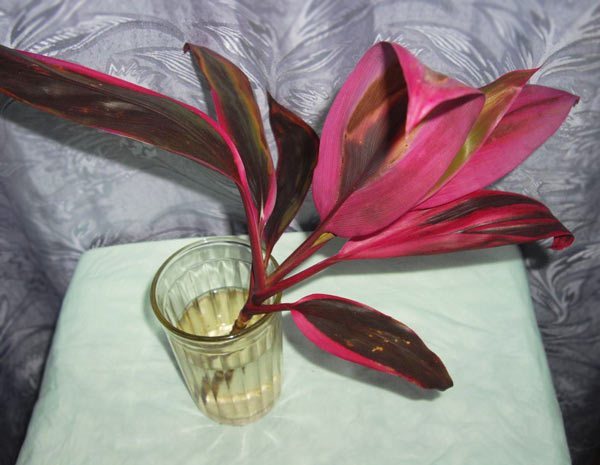

An easier and more efficient way to reproduce is jigging root babies, which, under good conditions, are produced abundantly. The shoot is cut off with a part of the root and, sprinkling the wound with activated carbon, is planted in a pot with light, fertile soil. You do not need to cover the plant.
In the event that a shoot is accidentally broken off from the plant, if desired, you can try to root it. This method should not be used as a method of planned breeding. The broken part is cut evenly and placed in a jar of water, which is covered with a dark film (the plant will not give roots in the light).
It is optimal to add a little substance to the water that promotes the formation of roots. As soon as the shoot forms a high-quality root, it is planted in a soil suitable for the plant.
In this video, an amateur florist shares his experience of cuttings and care:
Reproduction of cordilina
It is carried out in several ways:
- Cuttings. With a well-sharpened knife, cut off semi-lignified branches, 5-6 cm long, with at least one knot. Root in sand, vermiculite or water with added charcoal. Until roots appear (about 7-14 days), keep at a temperature of about 25 ° C, in partial shade. Plant in a small pot, do not compact the soil.
- Division of rhizomes. Divide the mother bush into several parts, remove all small roots. Plant in a light substrate. After rooting, transplant into the usual soil.
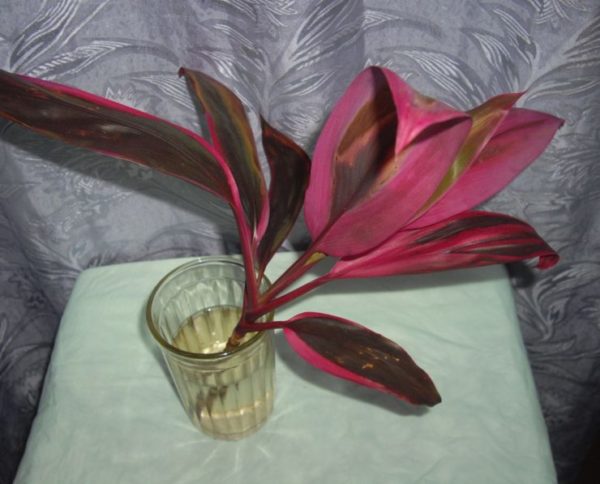

Cordilina also propagates by seed. But this method takes too long. In addition, the planting material obtained from varietal plants is not able to convey the properties of the mother bush.
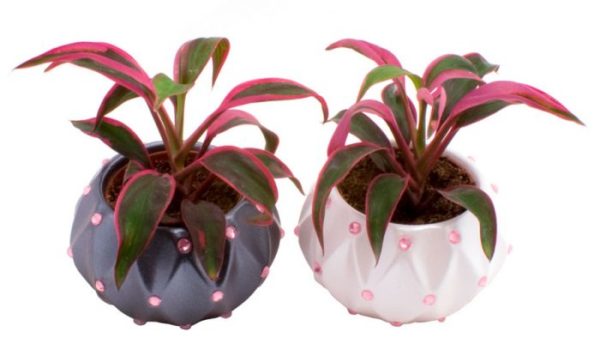

Diseases and pests
The main disease that can affect a tree is root rot. The leaves become drooping, the shoots lose their elasticity. To save a false palm, you need to remove it from the flowerpot, rinse the roots, remove damaged parts, treat with activated carbon or fungicide. Then, transplant into a new pot. If the entire root system has died, it is worth cutting off the top and rooting.
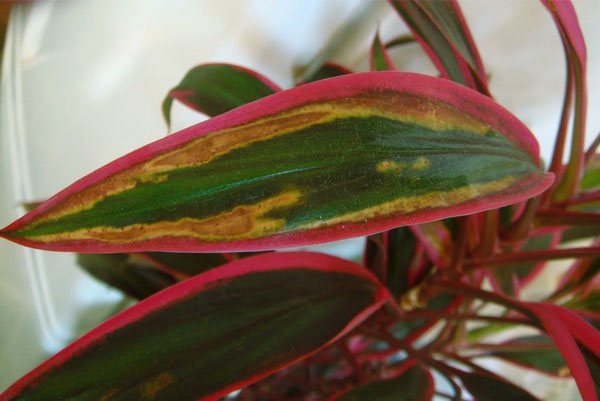

When growing cordilina, the following problems may arise:
Pests, diseases and possible problems
Cordelin is affected by scale insects, aphids, spider mites, thrips and mealybugs - treat the plant with an insecticide. Remember that spider mites only annoy plants that are not sprayed enough.
- The bottom of the stem has rotted - overflow.
- Light drying spots on the leaves - sunburn.
- The variegated leaves turned green - insufficient lighting, move the cordeline to a lighter place and gradually the leaves will become variegated again.
- Brown spots on the leaves - over-watering.
- The leaves lose their elasticity, curl and darken - the temperature is too low.
- Dry tips or edges of leaves - dry indoor air.
- The soil is covered with a whitish coating - it is salt from very hard water, you need to carefully remove the top layer of soil and replace it with a new one.
- Only the lower leaves fall - a natural growth process.
Planting and transplanting: choosing a pot, soil composition, step by step instructions
Cordilins at a young age are usually transplanted annually in the spring, and adult specimens every two years. But this rule can be broken. If the plant is developing well, does not cause concern, it is better not to disturb it. Even the most skilled transplant is stressful. But in some situations, a transplant is the only way out. When is it necessary to transplant cordilina?
- the plant has clearly outgrown the pot, the roots are crawling out of the drainage holes;
- cordilina lives in a pot for more than three years, there is no growth, the leaves began to turn yellow en masse;
- signs of waterlogging of the soil are noticeable, it turns sour, there is a suspicion of root decay;
- midges fly around the pot, parasites are seen in the ground.
The root system of the cordilina develops inward, there are few lateral processes. Therefore, when choosing a new pot, pay attention to high containers, where there will be enough room for root development. The sizes depend on the height. Landmark - a plant 40–45 cm tall, it needs a pot 15–20 cm in diameter. And every 2-3 years, increase it by 2-3 cm. It is not worth saving and taking dishes for growth. The roots will not be able to settle in a large volume of soil, moisture will stagnate and a putrefactive process will begin.
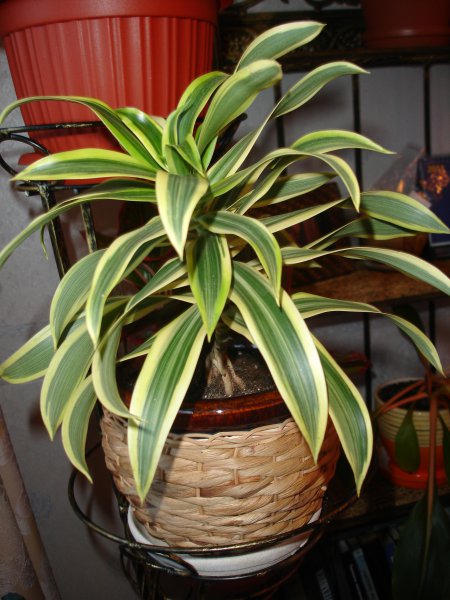

Cordilina will be uncomfortable in a pot that is too bulky
Cordilina grows equally well in a pot made of any material: plastic or ceramic. So rely on your taste and finances. But be sure to check the drainage holes in the pot, and if they are not there, make them. They need to be large enough to rid the plant of unnecessary moisture.
False palms will like an airy, moderately nutritious, neutral or slightly acidic (6–6.5 pH) substrate with a small addition of loosening agents and peat. You can buy specialized palm soil or mix it yourself. Here are some formulations:
- sod land - 2 parts, leaf and compost land - 1 part each, peat - 0.5;
- 2 shares of sod land, 1 deciduous and 0.5 coarse sand;
- equal parts of leafy land, high peat, chopped moss and half the share of perlite or coarse sand;
- into two parts of rotted compost or humus over a part of leafy earth, sand or vermiculite;
- sod land, greenhouse and deciduous humus in equal shares, half river sand;
- dilute the universal soil for indoor plants with garden soil by half, add a little chopped moss.
Useful additives can be added to the soil mixture: charcoal or red brick chips. Coal protects roots and soil from rot, while bricks increase looseness and absorb excess moisture. The proportion is approximately the following: for a bucket of soil there are 3-4 handfuls of coal and 0.5 kg of crumbled bricks. Expanded clay, pebbles, vermiculite, brick chips or polystyrene are suitable for the drainage layer.
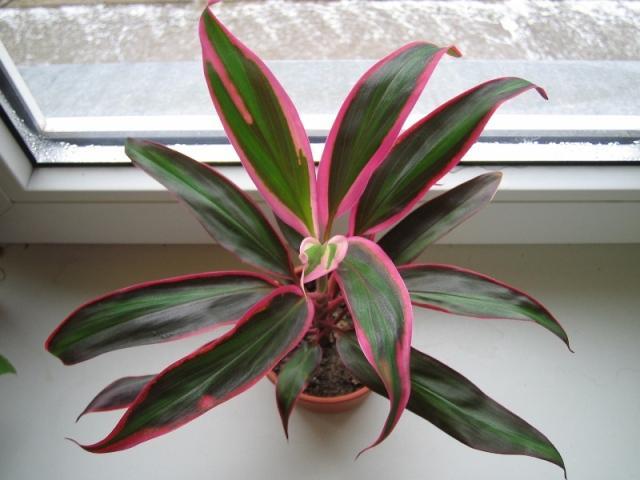

Cordeline, if there are no problems with the soil, it is better to transfer to a new pot so as not to injure the roots
Before planting, do not be too lazy to sterilize the soil (including store) and drainage. This procedure will destroy fungi that cause putrefactive and other diseases, and the larvae of parasites lurking in the soil.
Plant transshipment
Transfer is the most gentle type of transfer. It is suitable for healthy mature plants that need a little more room to grow. During transshipment, the earthen one is kept unchanged.
- Do not water the cordilina for 3-4 days before transshipment in order to preserve the earthen ball.
- Prepare new soil, drainage, and pot.
- Pour a drainage layer at the bottom, a little soil.
- Tilt the pot with a cordeline or, if the size allows, turn it over to get an earthen ball with roots. You can push it through the drain hole.
- Place an earthen ball in the center of the new pot, with the top just slightly below the edge, and free space at the sides.
- Add soil gradually from different sides, compacting with your fingers and shaking the pot.
- Do not fill the pot to the top for easy watering and leave no voids.
- After finishing the transplant, water the cordilina well.
- Place it in a warm (+ 20–22) slightly shaded place.
- Water sparingly for two weeks without overflowing and sprinkle occasionally.
- Observe the condition of the plant. If problems persist, place the flower in its permanent place and care for it as usual.
Purchasing a flower in a pot
When buying cordilina, be careful. Look at the foliage, it should be clean with whole, undried tips. It is not uncommon to see a false palm tree with cut leaves. This means that the plant is incorrectly kept: in too dry air or without watering. And they try to mask mistakes with a haircut. Inspect the underside of the leaves and stem for signs of pests.
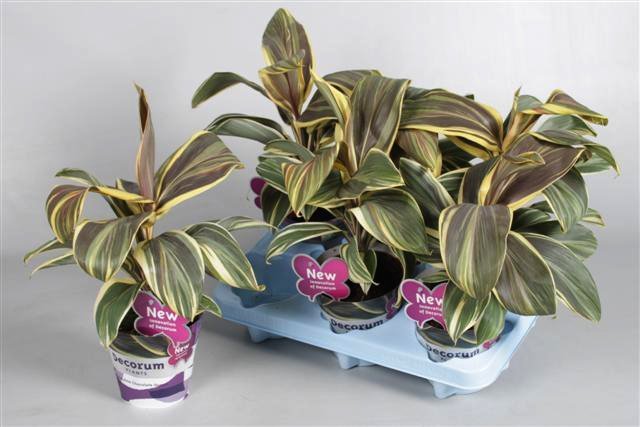

Before buying, carefully inspect the cordilina, and keep it in quarantine at home
When you bring the cordilina home, keep it in quarantine for at least 2 weeks. During this time, problems that have not been noticed in the store may appear. In addition, the cordilina needs to adapt to the new home.
And after two weeks, the question must be resolved: to transplant the flower or not. If there is no doubt about the health of the plant, wait until spring with a transplant. There are some problems, for example, poor soil quality, replant your false palm at any time of the year. Do not clean out the root system completely, but remove only what is lagging behind.
Prop for false palm
All cordilins have thin trunks, over the years they only slightly thicken.And the older the plant becomes, the greater the mass of leaves it has to keep. Therefore, a tall cordiline may need support. To keep the trunk from tilting, tie it to a bamboo stick, or purchase a coconut-wrapped tube from a flower shop.
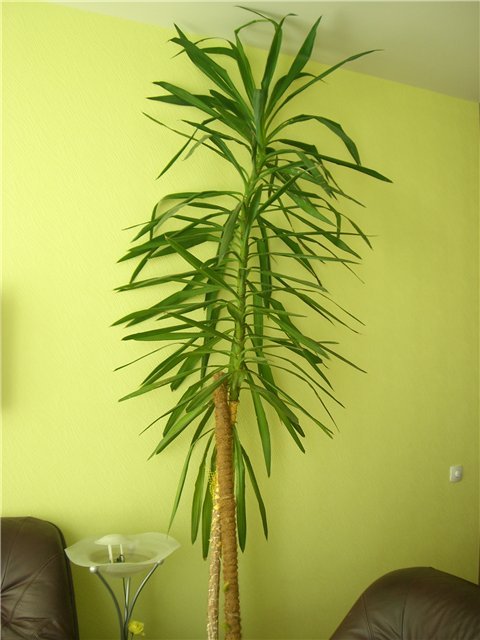

It is better to fix the thin stem of the cordiline on the support
You can make a support yourself, which will serve as an additional source of air humidification. It is made from a plastic pipe in which holes are drilled, peat, moss or coconut substrate is laid inside, and it is also wrapped outside.
Home care
Cordilin does not require special care at home. It is believed that the plant is extremely unpretentious and very responsive to even the most minimal care. As a tropical plant, it gravitates towards warmth and sun, moderate air humidity and lack of drafts.
Features of care after purchase
A newly purchased copy requires careful maintenance and a 2-week quarantine. It is important to inspect it for pests and diseases, thoroughly spill an earthen lump with water and simple soap and put it away from other green pets.
If insects are found in the pot, an urgent transplant and insecticide treatment will be needed. After the specified period, making sure that the plant is healthy, you can transplant it into a new container.
To the amount of light, the most demanding types of Cordilina with green leaves, variegated prefer the location in partial shade, because from too bright light they can lose their "patterns". Professionals advise to adhere to the rule: the darker the foliage of Cordilina, the less light it will need.
Species with dark green leaves can live even in the back of a room. In any case, it is better to protect the plant from direct sunlight on its foliage. And drafts and location next to heating devices can cause the death of a green pet. A western or eastern window sill is ideal.
Temperature
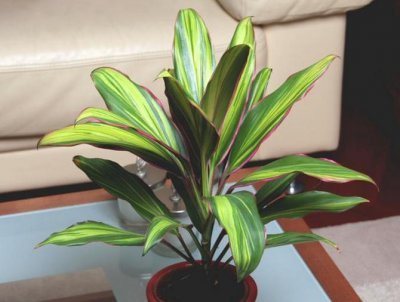

Caring for Cordilina at home requires a special temperature. From spring to autumn, Cordilina feels good at home at a moderate room temperature - from 15 to 26 ° C.
Most of the Cordilin will not refuse a cool wintering at 8 or 10 ° C. However, variegated false palms spend a dormant period at normal room temperature.
Air humidity
It is highly desirable to provide Cordilina with more or less humid air. In addition, if you regularly spray lush foliage and occasionally arrange a warm shower for the plant (avoiding the accumulation of water in the funnel of leaves), it will respond to the grower with gratitude and a luxurious look.
In the warm season, the beauty of Kordilina needs abundant watering (about 2-3 times a week), in winter - in moderate (1-2 times a week, with a slight drying of the upper layer of the earth). For a plant, both waterlogging of the soil and its overdrying are equally destructive. It is extremely dangerous to overdo it with watering when the room is cold.
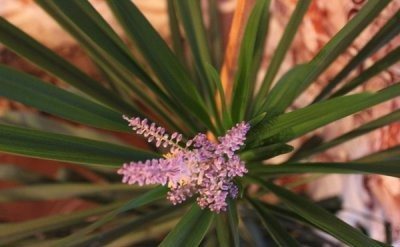

With good care, Cordilina can delight the grower with a panicle of charming flowers. Many species require a cool hibernation for this.
In the summer, Cordilina will not give up organic or mineral fertilizers. In this case, it is important to strictly follow the instructions, but apply a dose slightly less than indicated.
Young plants can be transplanted every year into a new pot with a slightly larger diameter - literally by 1-2 cm.At the age of 3-5, a green pet will prefer to be transplanted every few years by the transshipment method. In this case, you can change the top layer of soil in the pot once a year.
- Sod land;
- Leafy land;
- Coarse sand;
- Rotted manure.
Alternatively, you can simply purchase a suitable primer from a flower shop. An important condition for a successful transplant is a thick drainage layer at the bottom of the tank.The plant can also be kept hydroponically.
Growing
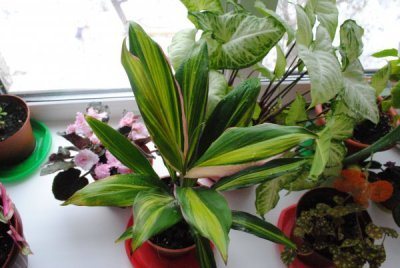

There are many ways to breed Cordilina.
With good care, the false palm acquires suckers that can be easily separated during transplantation.
Care
Caring for cordilins is careful watering, loosening the soil, spraying, as well as cleaning: regularly rubbing the leaves and removing the sluggish and weak. For variegated forms, it will be useful to arrange supplementary lighting in the winter. And to grow a dense branchy crown, you will need pruning.
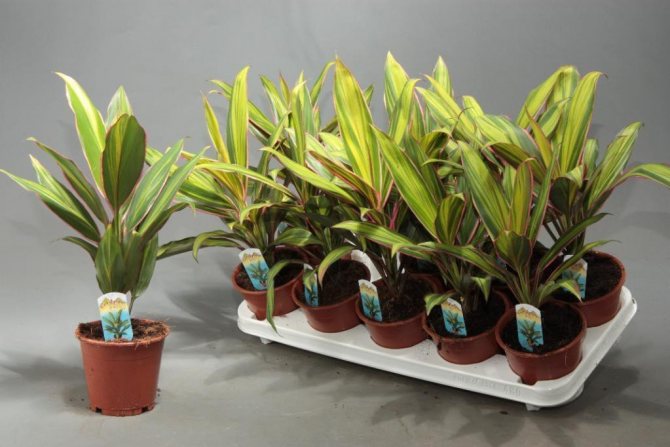

Caring for codilina is simple, but attention must be paid to it
Watering and feeding
Summer watering of the cordilina should be abundant, the hotter, the more. In winter, water is given limitedly, but the soil is not brought to complete dryness. And the lower the temperature, the less humidification. Cordilines with wider leaves consume more moisture, so they will need to be watered more often. Narrow-leaved types of water require less.
Excess moisture at the roots leads to diseases. Therefore, it is useful to loosen the top layer of soil so that air penetrates into the pot.
Use water for irrigation and spraying soft (settled, filtered) and slightly warm (22-25 degrees).
In spring and summer, cordilina can be fed with fertilizer for decorative leafy plants. Add liquid fertilizers to watering every two weeks. Any complexes will do, but when feeding variegated varieties, pay attention to the nitrogen content. An excess of this element leads to greening of the leaves.
Rest period and backlight
In winter, the plant's metabolic processes slow down. Cordilina falls into a kind of hibernation. The plant needs coolness, but the temperature of the content is different for different species (about this in the table "Conditions"). One thing is the same - at low temperatures it is necessary to protect cordilina from hypothermia of the roots. If the plant hibernates on a windowsill, place the pot on a piece of styrofoam or wood to keep it warm. If the cordilina spends a dormant period on the balcony, wrap the pot in warm insulating material.
At low temperatures (less than +15), cordilina does not need high air humidity. Watering should also be limited to a minimum so that the soil is barely damp. Heat-loving species also need to be watered more modestly, but sprayed regularly.
And the length of daylight hours should be increased for all cordilines. But especially for colorful ones. Lack of light will lead to a loss of bright color. For backlights need fluorescent or LED lamps. They do not heat or dry the air, and plants perceive the spectrum they emit well.
Formation
Over the years, cordilina, like a real palm tree, loses its lower leaves. This is a natural phenomenon. You need to worry if the leaf fall has become massive. Remove wilted leaves to make it easier for the plant.
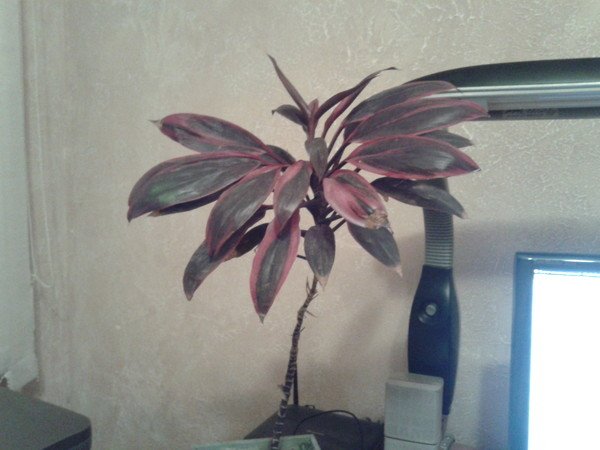

This cordeline needs shaping
To stimulate the lateral kidneys and rejuvenate the cordiline, it is recommended to cut it off. Healthy plants, not less than 30 cm tall, cut off the top with a sharp knife, about 6 cm.It can be rooted and planted in the same pot, if there is enough space. The wound on the remaining stem must be lubricated with garden varnish or sprinkled with coal. And after about 2–4 weeks, new shoots from the lateral buds should appear under the cut.
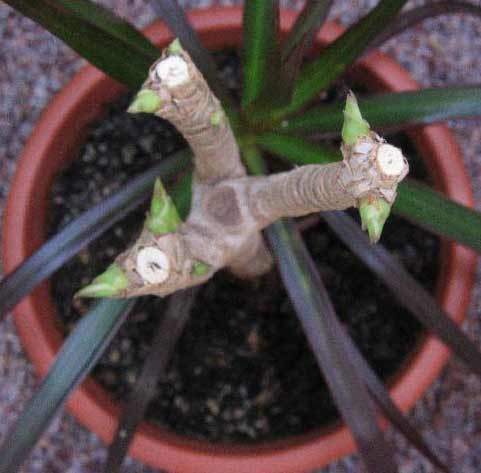

Trimming the crown causes the lateral buds to develop
Care errors (table)
| Manifestation | Cause | Decision |
| Leaves or their edges and tips dry out. |
|
|
| Leaves turn yellow and die. |
Loss of old lower leaves is the norm. |
|
| The leaves lose their firmness, they are soft with a brown edge. | Exposure to low temperatures. | Heat-loving cordilins do not tolerate temperatures below +16. Do not place the pot close to the cold window glass, do not open the window window next to it. |
| Light dryish spots appear on the leaves. | Too much sun, it burns the leaves. | In spring and summer, cordilina should be shaded from the sun at noon. |

